Layout Optimization of Offshore Wind Energy Project for Maximum Energy Capture with Variable Hub Height
VerifiedAdded on 2023/04/25
|24
|10340
|481
AI Summary
This research paper discusses the optimization of the layout of offshore wind energy projects for maximum energy capture with variable hub height. The study uses a gradient-based optimization method to optimize wind farms with different hub heights. The paper includes a modified version of the FLORIS wake model that accommodates three-dimensional wakes integrated with a power structural model. The results indicate that optimizing the layout and height of wind turbines can reduce the cost of energy by up to 5-9%. The paper is a research paper on renewable energy technology and management.
Contribute Materials
Your contribution can guide someone’s learning journey. Share your
documents today.
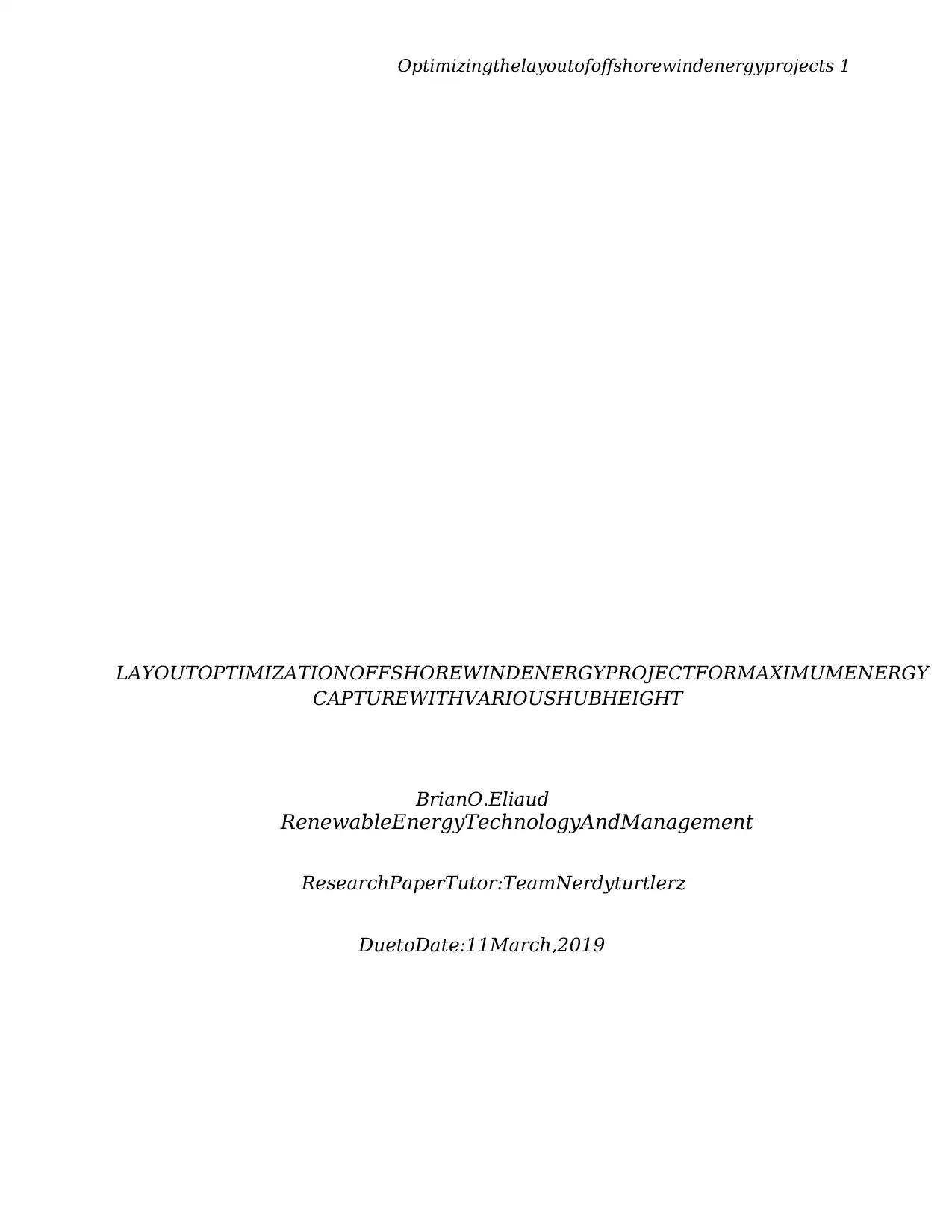
Optimizingthelayoutofoffshorewindenergyprojects 1
LAYOUTOPTIMIZATIONOFFSHOREWINDENERGYPROJECTFORMAXIMUMENERGY
CAPTUREWITHVARIOUSHUBHEIGHT
BrianO.Eliaud
RenewableEnergyTechnologyAndManagement
ResearchPaperTutor:TeamNerdyturtlerz
DuetoDate:11March,2019
LAYOUTOPTIMIZATIONOFFSHOREWINDENERGYPROJECTFORMAXIMUMENERGY
CAPTUREWITHVARIOUSHUBHEIGHT
BrianO.Eliaud
RenewableEnergyTechnologyAndManagement
ResearchPaperTutor:TeamNerdyturtlerz
DuetoDate:11March,2019
Secure Best Marks with AI Grader
Need help grading? Try our AI Grader for instant feedback on your assignments.
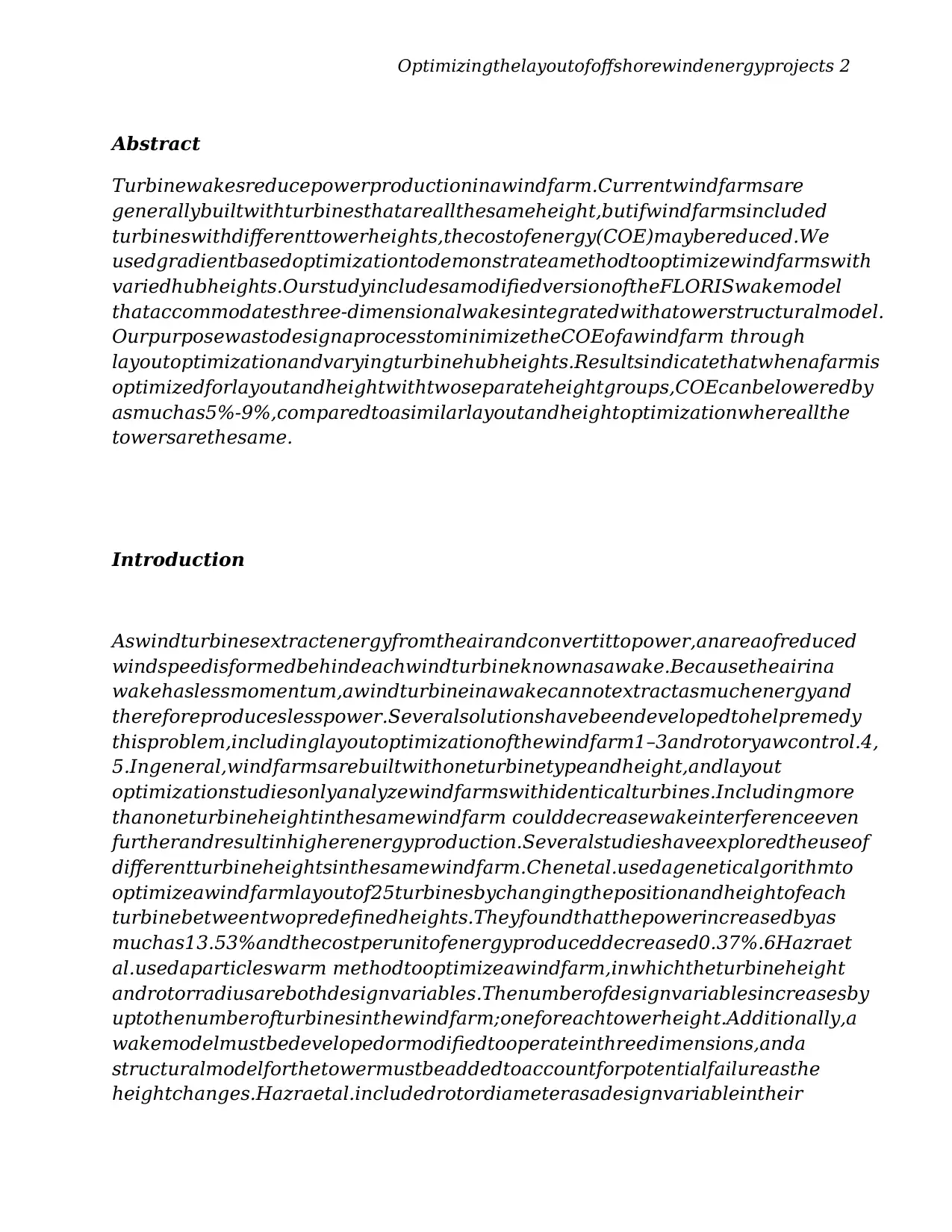
Optimizingthelayoutofoffshorewindenergyprojects 2
Abstract
Turbinewakesreducepowerproductioninawindfarm.Currentwindfarmsare
generallybuiltwithturbinesthatareallthesameheight,butifwindfarmsincluded
turbineswithdifferenttowerheights,thecostofenergy(COE)maybereduced.We
usedgradientbasedoptimizationtodemonstrateamethodtooptimizewindfarmswith
variedhubheights.OurstudyincludesamodifiedversionoftheFLORISwakemodel
thataccommodatesthree-dimensionalwakesintegratedwithatowerstructuralmodel.
OurpurposewastodesignaprocesstominimizetheCOEofawindfarm through
layoutoptimizationandvaryingturbinehubheights.Resultsindicatethatwhenafarmis
optimizedforlayoutandheightwithtwoseparateheightgroups,COEcanbeloweredby
asmuchas5%-9%,comparedtoasimilarlayoutandheightoptimizationwhereallthe
towersarethesame.
Introduction
Aswindturbinesextractenergyfromtheairandconvertittopower,anareaofreduced
windspeedisformedbehindeachwindturbineknownasawake.Becausetheairina
wakehaslessmomentum,awindturbineinawakecannotextractasmuchenergyand
thereforeproduceslesspower.Severalsolutionshavebeendevelopedtohelpremedy
thisproblem,includinglayoutoptimizationofthewindfarm1–3androtoryawcontrol.4,
5.Ingeneral,windfarmsarebuiltwithoneturbinetypeandheight,andlayout
optimizationstudiesonlyanalyzewindfarmswithidenticalturbines.Includingmore
thanoneturbineheightinthesamewindfarm coulddecreasewakeinterferenceeven
furtherandresultinhigherenergyproduction.Severalstudieshaveexploredtheuseof
differentturbineheightsinthesamewindfarm.Chenetal.usedageneticalgorithmto
optimizeawindfarmlayoutof25turbinesbychangingthepositionandheightofeach
turbinebetweentwopredefinedheights.Theyfoundthatthepowerincreasedbyas
muchas13.53%andthecostperunitofenergyproduceddecreased0.37%.6Hazraet
al.usedaparticleswarm methodtooptimizeawindfarm,inwhichtheturbineheight
androtorradiusarebothdesignvariables.Thenumberofdesignvariablesincreasesby
uptothenumberofturbinesinthewindfarm;oneforeachtowerheight.Additionally,a
wakemodelmustbedevelopedormodifiedtooperateinthreedimensions,anda
structuralmodelforthetowermustbeaddedtoaccountforpotentialfailureasthe
heightchanges.Hazraetal.includedrotordiameterasadesignvariableintheir
Abstract
Turbinewakesreducepowerproductioninawindfarm.Currentwindfarmsare
generallybuiltwithturbinesthatareallthesameheight,butifwindfarmsincluded
turbineswithdifferenttowerheights,thecostofenergy(COE)maybereduced.We
usedgradientbasedoptimizationtodemonstrateamethodtooptimizewindfarmswith
variedhubheights.OurstudyincludesamodifiedversionoftheFLORISwakemodel
thataccommodatesthree-dimensionalwakesintegratedwithatowerstructuralmodel.
OurpurposewastodesignaprocesstominimizetheCOEofawindfarm through
layoutoptimizationandvaryingturbinehubheights.Resultsindicatethatwhenafarmis
optimizedforlayoutandheightwithtwoseparateheightgroups,COEcanbeloweredby
asmuchas5%-9%,comparedtoasimilarlayoutandheightoptimizationwhereallthe
towersarethesame.
Introduction
Aswindturbinesextractenergyfromtheairandconvertittopower,anareaofreduced
windspeedisformedbehindeachwindturbineknownasawake.Becausetheairina
wakehaslessmomentum,awindturbineinawakecannotextractasmuchenergyand
thereforeproduceslesspower.Severalsolutionshavebeendevelopedtohelpremedy
thisproblem,includinglayoutoptimizationofthewindfarm1–3androtoryawcontrol.4,
5.Ingeneral,windfarmsarebuiltwithoneturbinetypeandheight,andlayout
optimizationstudiesonlyanalyzewindfarmswithidenticalturbines.Includingmore
thanoneturbineheightinthesamewindfarm coulddecreasewakeinterferenceeven
furtherandresultinhigherenergyproduction.Severalstudieshaveexploredtheuseof
differentturbineheightsinthesamewindfarm.Chenetal.usedageneticalgorithmto
optimizeawindfarmlayoutof25turbinesbychangingthepositionandheightofeach
turbinebetweentwopredefinedheights.Theyfoundthatthepowerincreasedbyas
muchas13.53%andthecostperunitofenergyproduceddecreased0.37%.6Hazraet
al.usedaparticleswarm methodtooptimizeawindfarm,inwhichtheturbineheight
androtorradiusarebothdesignvariables.Thenumberofdesignvariablesincreasesby
uptothenumberofturbinesinthewindfarm;oneforeachtowerheight.Additionally,a
wakemodelmustbedevelopedormodifiedtooperateinthreedimensions,anda
structuralmodelforthetowermustbeaddedtoaccountforpotentialfailureasthe
heightchanges.Hazraetal.includedrotordiameterasadesignvariableintheir

Optimizingthelayoutofoffshorewindenergyprojects 3
optimization.Gradient-basedoptimizationisfasterthangradient-freemethodsandis
necessaryforoptimizinglargewindfarmsincludingmanydesignvariables,suchasyaw
controlcoupledwiththevariablesmentionedabove.Whenyawcontrolisaddedtothe
optimization,thousandsofdesignvariablescanbeadded,becauseeachturbinemust
beoptimizedforeachwinddirectioninconsideration.Specifically,wewilloptimizewind
farmswithdifferenthubheights,anddemonstrategainsofwindfarmswithmultiple
hubheightscomparedtothosewithturbinesatanidenticalheight.Combiningmultiple
hubheightsinwindfarmswhilecontinuingtooptimizetheirlayoutmayhavesignificant
impactonthecostofenergy(COE)inwindfarms.
Methodology
Inthissection,wedescribethemodelusedtopredicttheCOEofawindfarm.First,the
wakemodelisdiscussed,whichisneededtocalculatethewindspeedatanypointin
thewindfarm.Next,wediscusstheannualenergyproduction(AEP)andhow itis
calculated.Consideringstructuralcalculationsmadealongthelengthofthetowerthat
areimportantasconstraintsinouroptimization,eachofthesecomponentswasusedin
ouroptimization.
A.WakeModel
Tocalculatetheeffectivewindspeedateachturbine,weusedtheFLORISwake
modelpresentedbyGebraadetal.4TheFLORISwakemodelisderivedfrom the
Jensenmodel,8butratherthanuseonespeedtodescribethewindacrossthe
wake,threeseparatezonesaredefined,eachwithadifferentexpansionand
decayrate.Asimpleoverlapratioisusedbetweenzonestodefinethetotal
effectivewindspeedateachturbine.Figure1showsthethreeseparatewake
zones,aswellastheiroverlaponarotor.Withoutanalyticgradients,finite
differencegradientsmustbeused,whichoftenexperiencenumericaldifficulties,
anddonotscalewell.Becausethiswakemodelwasdesignedtodescribethe
wakeinthehorizontalplane,itwasmodifiedtocalculatetheeffectivewind
speedatanypointinthree-dimensional(3-Dspace.Weassumethatthewakeis
optimization.Gradient-basedoptimizationisfasterthangradient-freemethodsandis
necessaryforoptimizinglargewindfarmsincludingmanydesignvariables,suchasyaw
controlcoupledwiththevariablesmentionedabove.Whenyawcontrolisaddedtothe
optimization,thousandsofdesignvariablescanbeadded,becauseeachturbinemust
beoptimizedforeachwinddirectioninconsideration.Specifically,wewilloptimizewind
farmswithdifferenthubheights,anddemonstrategainsofwindfarmswithmultiple
hubheightscomparedtothosewithturbinesatanidenticalheight.Combiningmultiple
hubheightsinwindfarmswhilecontinuingtooptimizetheirlayoutmayhavesignificant
impactonthecostofenergy(COE)inwindfarms.
Methodology
Inthissection,wedescribethemodelusedtopredicttheCOEofawindfarm.First,the
wakemodelisdiscussed,whichisneededtocalculatethewindspeedatanypointin
thewindfarm.Next,wediscusstheannualenergyproduction(AEP)andhow itis
calculated.Consideringstructuralcalculationsmadealongthelengthofthetowerthat
areimportantasconstraintsinouroptimization,eachofthesecomponentswasusedin
ouroptimization.
A.WakeModel
Tocalculatetheeffectivewindspeedateachturbine,weusedtheFLORISwake
modelpresentedbyGebraadetal.4TheFLORISwakemodelisderivedfrom the
Jensenmodel,8butratherthanuseonespeedtodescribethewindacrossthe
wake,threeseparatezonesaredefined,eachwithadifferentexpansionand
decayrate.Asimpleoverlapratioisusedbetweenzonestodefinethetotal
effectivewindspeedateachturbine.Figure1showsthethreeseparatewake
zones,aswellastheiroverlaponarotor.Withoutanalyticgradients,finite
differencegradientsmustbeused,whichoftenexperiencenumericaldifficulties,
anddonotscalewell.Becausethiswakemodelwasdesignedtodescribethe
wakeinthehorizontalplane,itwasmodifiedtocalculatetheeffectivewind
speedatanypointinthree-dimensional(3-Dspace.Weassumethatthewakeis

Optimizingthelayoutofoffshorewindenergyprojects 4
axisymmetric,suchthatanycrosssectioniscircular.FLORISusesprecomputed
data,uniquetotheturbinemodelused,fortheCPandCTcurvesthatareusedin
theturbinepowercalculation.Arealwakemaymoveintheverticalplaneand
maynotmaintainaperfectlycircularcrosssection.Tolearnwhetherornotthe
assumptionswemadewerereasonable,wecomparedthemodelresultsto
SimulatorforWindFarm Applications(SOWFA).SOWFA,ahigh-fidelitylarge
eddysimulationtoolthatwasdevelopedattheNationalRenewableEnergy
Laboratory(NREL)forwindfarmstudies,isbasedonOpenFOAMandiscoupled
withNREL’sFASTmodelingtool.SOWFAsolvesthe3-DincompressibleNavier-
Stokesequationsandtransportofpotentialtemperatureequations,whichtake
intoaccountthethermalbuoyancyandEarthrotation(Carioles)effectsinthe
atmosphere.Theinflowconditionsforthesesimulationsaregeneratedusinga
periodic atmospheric boundary layerprecursorwith no turbines.SOWFA
calculatestheunsteadyflowfieldtocomputethetime-varyingpower,velocity
deficits,andloadsateachturbineinawindplant.SOWFAhasbeencompared
withthe48-Lillgrundwindfarm fielddataandshowsgoodagreementthrough
thefirstfiveturbinesinarowalignedwiththewinddirection.Inaddition,SOWFA
hasbeentestedtoverifythatitcapturestheinertialrangeintheturbulentenergy
spectraandloglayerinthemeanflow,bothofwhichcharacterizeareal
atmosphericboundarylayer.TheturbinesweresimulatedusingtheNREL5-MW
referenceturbine17andwerespaced7rotordiameters(7D)apartinthe
downstream direction. These scenarios were simulated under neutral
atmosphericconditionswithan8m/smeanwindspeedand10%turbulence
intensity.A baseline scenario was run in which both the upstream and
downstream turbinesweresimulatedatahubheightof90m.Next,thehub
heightofthedownstream turbinewasvariedtoverifythatFLORIS-3Dcould
axisymmetric,suchthatanycrosssectioniscircular.FLORISusesprecomputed
data,uniquetotheturbinemodelused,fortheCPandCTcurvesthatareusedin
theturbinepowercalculation.Arealwakemaymoveintheverticalplaneand
maynotmaintainaperfectlycircularcrosssection.Tolearnwhetherornotthe
assumptionswemadewerereasonable,wecomparedthemodelresultsto
SimulatorforWindFarm Applications(SOWFA).SOWFA,ahigh-fidelitylarge
eddysimulationtoolthatwasdevelopedattheNationalRenewableEnergy
Laboratory(NREL)forwindfarmstudies,isbasedonOpenFOAMandiscoupled
withNREL’sFASTmodelingtool.SOWFAsolvesthe3-DincompressibleNavier-
Stokesequationsandtransportofpotentialtemperatureequations,whichtake
intoaccountthethermalbuoyancyandEarthrotation(Carioles)effectsinthe
atmosphere.Theinflowconditionsforthesesimulationsaregeneratedusinga
periodic atmospheric boundary layerprecursorwith no turbines.SOWFA
calculatestheunsteadyflowfieldtocomputethetime-varyingpower,velocity
deficits,andloadsateachturbineinawindplant.SOWFAhasbeencompared
withthe48-Lillgrundwindfarm fielddataandshowsgoodagreementthrough
thefirstfiveturbinesinarowalignedwiththewinddirection.Inaddition,SOWFA
hasbeentestedtoverifythatitcapturestheinertialrangeintheturbulentenergy
spectraandloglayerinthemeanflow,bothofwhichcharacterizeareal
atmosphericboundarylayer.TheturbinesweresimulatedusingtheNREL5-MW
referenceturbine17andwerespaced7rotordiameters(7D)apartinthe
downstream direction. These scenarios were simulated under neutral
atmosphericconditionswithan8m/smeanwindspeedand10%turbulence
intensity.A baseline scenario was run in which both the upstream and
downstream turbinesweresimulatedatahubheightof90m.Next,thehub
heightofthedownstream turbinewasvariedtoverifythatFLORIS-3Dcould
Paraphrase This Document
Need a fresh take? Get an instant paraphrase of this document with our AI Paraphraser
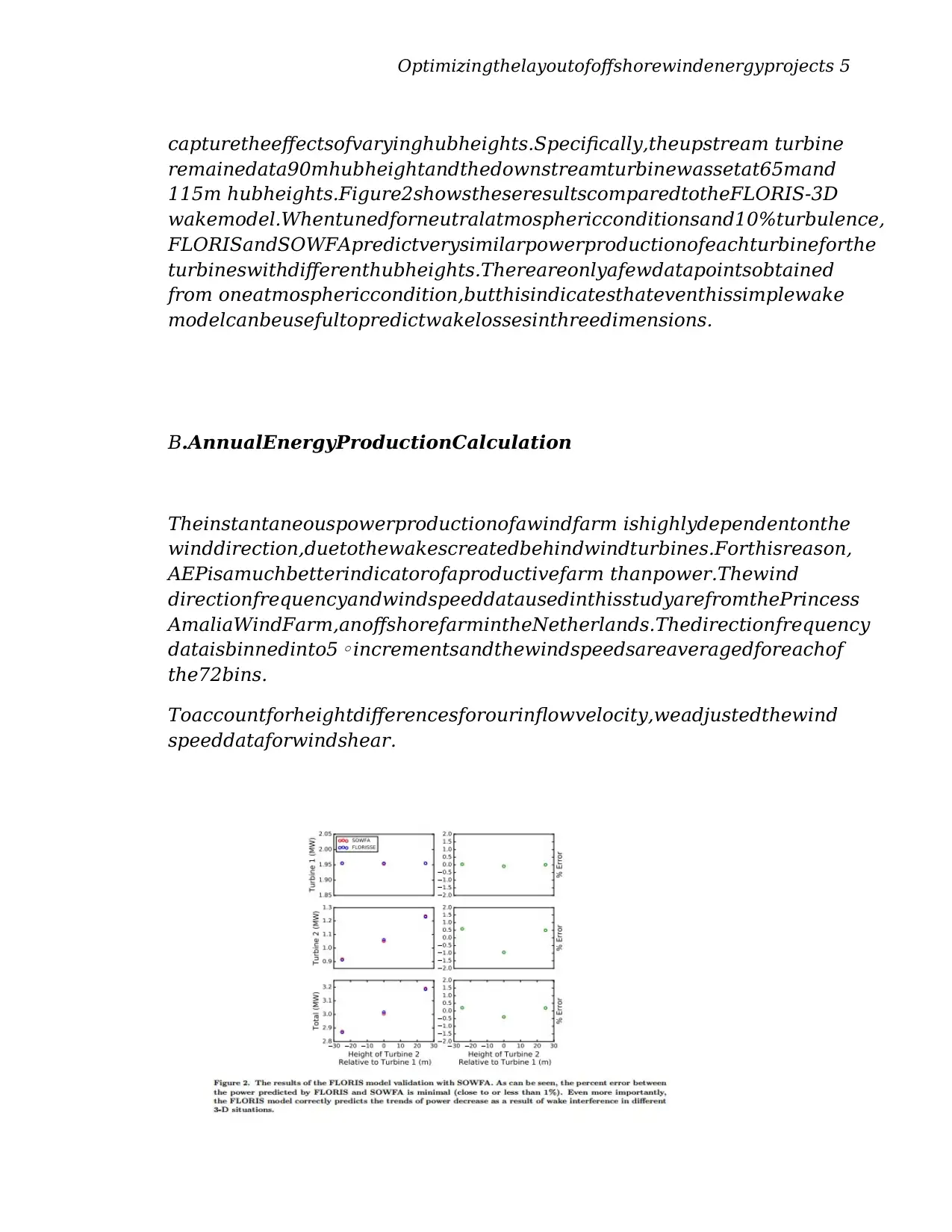
Optimizingthelayoutofoffshorewindenergyprojects 5
capturetheeffectsofvaryinghubheights.Specifically,theupstream turbine
remainedata90mhubheightandthedownstreamturbinewassetat65mand
115m hubheights.Figure2showstheseresultscomparedtotheFLORIS-3D
wakemodel.Whentunedforneutralatmosphericconditionsand10%turbulence,
FLORISandSOWFApredictverysimilarpowerproductionofeachturbineforthe
turbineswithdifferenthubheights.Thereareonlyafewdatapointsobtained
from oneatmosphericcondition,butthisindicatesthateventhissimplewake
modelcanbeusefultopredictwakelossesinthreedimensions.
B.AnnualEnergyProductionCalculation
Theinstantaneouspowerproductionofawindfarm ishighlydependentonthe
winddirection,duetothewakescreatedbehindwindturbines.Forthisreason,
AEPisamuchbetterindicatorofaproductivefarm thanpower.Thewind
directionfrequencyandwindspeeddatausedinthisstudyarefromthePrincess
AmaliaWindFarm,anoffshorefarmintheNetherlands.Thedirectionfrequency
dataisbinnedinto5
◦incrementsandthewindspeedsareaveragedforeachof
the72bins.
Toaccountforheightdifferencesforourinflowvelocity,weadjustedthewind
speeddataforwindshear.
capturetheeffectsofvaryinghubheights.Specifically,theupstream turbine
remainedata90mhubheightandthedownstreamturbinewassetat65mand
115m hubheights.Figure2showstheseresultscomparedtotheFLORIS-3D
wakemodel.Whentunedforneutralatmosphericconditionsand10%turbulence,
FLORISandSOWFApredictverysimilarpowerproductionofeachturbineforthe
turbineswithdifferenthubheights.Thereareonlyafewdatapointsobtained
from oneatmosphericcondition,butthisindicatesthateventhissimplewake
modelcanbeusefultopredictwakelossesinthreedimensions.
B.AnnualEnergyProductionCalculation
Theinstantaneouspowerproductionofawindfarm ishighlydependentonthe
winddirection,duetothewakescreatedbehindwindturbines.Forthisreason,
AEPisamuchbetterindicatorofaproductivefarm thanpower.Thewind
directionfrequencyandwindspeeddatausedinthisstudyarefromthePrincess
AmaliaWindFarm,anoffshorefarmintheNetherlands.Thedirectionfrequency
dataisbinnedinto5
◦incrementsandthewindspeedsareaveragedforeachof
the72bins.
Toaccountforheightdifferencesforourinflowvelocity,weadjustedthewind
speeddataforwindshear.

Optimizingthelayoutofoffshorewindenergyprojects 6
Weusedapowerlawtoestimatethewindspeedatdifferentheights(z):
U(z)=Uref(z)/zref^
α
wherethereferenceheight,zref,ofthereferenceturbineis90m,andtheshear
coefficient,wasvariedaswillbediscussedlater.
C.TowerModel
Becausethetowerheightwasallowedtovary,itwasnecessarytoincludea
modeltocalculatemassandperform structuralanalysisofthetower.The
structuralanalysiswasusedtoconstraintheoptimization,keepingthetowers
from growingunrealisticallytallwherefailurefrom stressorbucklingwouldbe
anissue.Itwasalsonecessarytoprovidegradientsforallofourconstraints,
whichincludedthevonMisesstress,shellbuckling,andglobalbucklingatany
pointalongthetower;thetowertaperratio;andthefirstnaturalfrequencyofthe
structure.NRELdevelopedafiniteelementmodelcalledTowerSEthatmakes
variouscalculationsalongthelengthofatower.Itisapowerfultool,butdoesnot
provideanalyticgradients.WeoptimizedseveralwindfarmsusingTowerSEand
finitedifferencegradients,andidentifiedtheshellbucklingandfirstnatural
frequencyastheonlyactiveconstraints.Wewerethenabletopulloutthe
necessarycalculationsfrom TowerSEandfindtheassociatedgradients.The
towermasswasasimplecalculationfrom thevolumeofthetower.The
gradientsweresimpletosolvebyhand.Wefoundshellbucklingasafunctionof
thetowergeometryandthestressesateachlocation,followingthemethod
outlinedinEurocode.ThesecalculationsweremadeinFortran90andexact
gradientswereobtainedwiththeTapenadeautomaticdifferentiationtool.We
simplifiedthefrequencycalculationbyapproximatingthetowerasacantilever
beam ofconstantcrosssectionwithanendmass.Weusedthemethod
describedbyErturketal.tocalculatethenaturalfrequency.Becausetheturbine
towerdoesnotreallyhaveaconstantmassdensityalongthelengthandthe
massfromtherotornacelleassemblyisslightlyoffsetatthetop,ourcalculation
isslightlymoreconservativethanthatpredictedbyTowerSEbyabout10%.For
thisreasonwescaledourfrequencycalculationby10%tomorecloselymatch
thefrequencycalculatedbyTowerSE.Wechosethissimplifiedmodelsothatwe
couldfindgradients,whichwereobtainedusinganalyticsensitivityequations.
Weusedapowerlawtoestimatethewindspeedatdifferentheights(z):
U(z)=Uref(z)/zref^
α
wherethereferenceheight,zref,ofthereferenceturbineis90m,andtheshear
coefficient,wasvariedaswillbediscussedlater.
C.TowerModel
Becausethetowerheightwasallowedtovary,itwasnecessarytoincludea
modeltocalculatemassandperform structuralanalysisofthetower.The
structuralanalysiswasusedtoconstraintheoptimization,keepingthetowers
from growingunrealisticallytallwherefailurefrom stressorbucklingwouldbe
anissue.Itwasalsonecessarytoprovidegradientsforallofourconstraints,
whichincludedthevonMisesstress,shellbuckling,andglobalbucklingatany
pointalongthetower;thetowertaperratio;andthefirstnaturalfrequencyofthe
structure.NRELdevelopedafiniteelementmodelcalledTowerSEthatmakes
variouscalculationsalongthelengthofatower.Itisapowerfultool,butdoesnot
provideanalyticgradients.WeoptimizedseveralwindfarmsusingTowerSEand
finitedifferencegradients,andidentifiedtheshellbucklingandfirstnatural
frequencyastheonlyactiveconstraints.Wewerethenabletopulloutthe
necessarycalculationsfrom TowerSEandfindtheassociatedgradients.The
towermasswasasimplecalculationfrom thevolumeofthetower.The
gradientsweresimpletosolvebyhand.Wefoundshellbucklingasafunctionof
thetowergeometryandthestressesateachlocation,followingthemethod
outlinedinEurocode.ThesecalculationsweremadeinFortran90andexact
gradientswereobtainedwiththeTapenadeautomaticdifferentiationtool.We
simplifiedthefrequencycalculationbyapproximatingthetowerasacantilever
beam ofconstantcrosssectionwithanendmass.Weusedthemethod
describedbyErturketal.tocalculatethenaturalfrequency.Becausetheturbine
towerdoesnotreallyhaveaconstantmassdensityalongthelengthandthe
massfromtherotornacelleassemblyisslightlyoffsetatthetop,ourcalculation
isslightlymoreconservativethanthatpredictedbyTowerSEbyabout10%.For
thisreasonwescaledourfrequencycalculationby10%tomorecloselymatch
thefrequencycalculatedbyTowerSE.Wechosethissimplifiedmodelsothatwe
couldfindgradients,whichwereobtainedusinganalyticsensitivityequations.
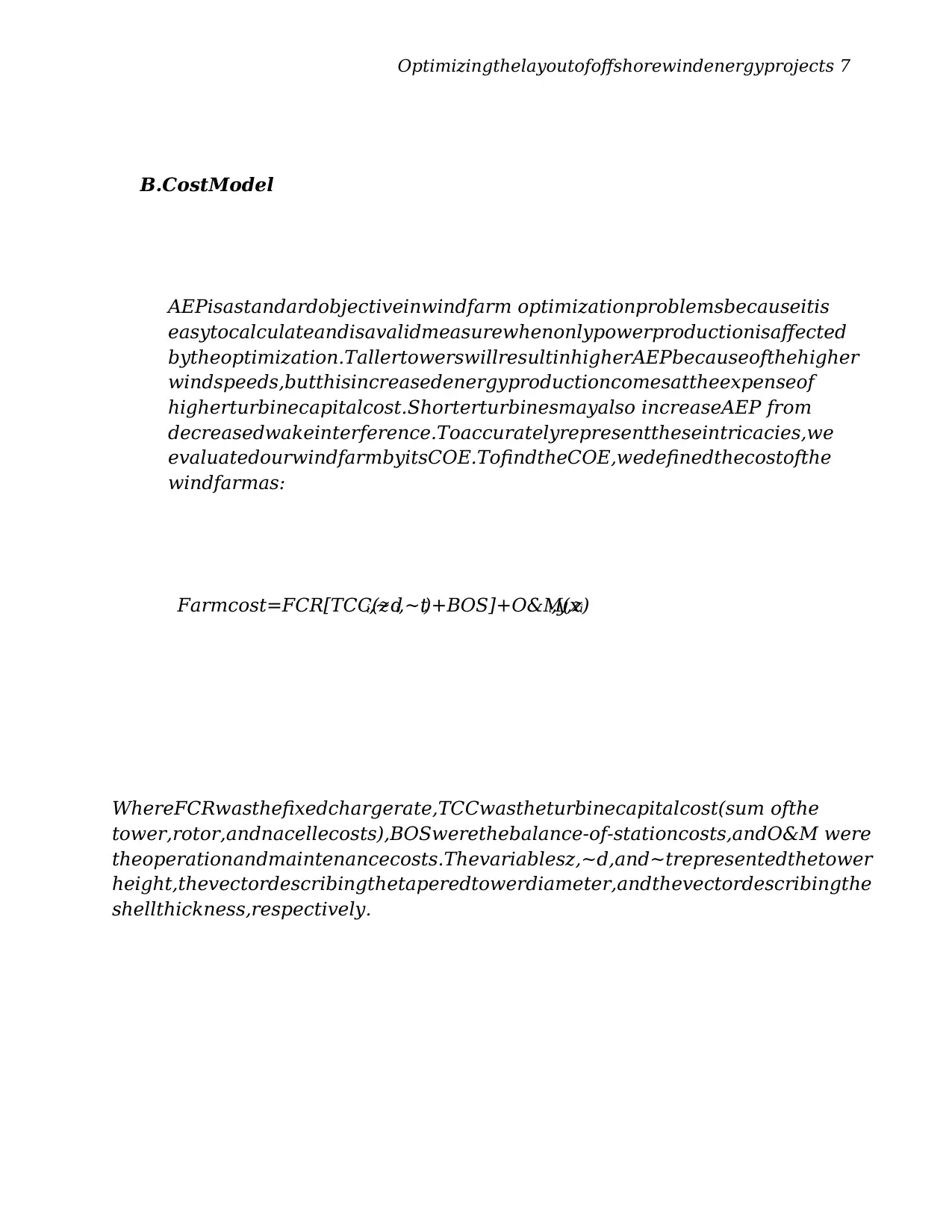
Optimizingthelayoutofoffshorewindenergyprojects 7
B.CostModel
AEPisastandardobjectiveinwindfarm optimizationproblemsbecauseitis
easytocalculateandisavalidmeasurewhenonlypowerproductionisaffected
bytheoptimization.TallertowerswillresultinhigherAEPbecauseofthehigher
windspeeds,butthisincreasedenergyproductioncomesattheexpenseof
higherturbinecapitalcost.Shorterturbinesmayalso increaseAEP from
decreasedwakeinterference.Toaccuratelyrepresenttheseintricacies,we
evaluatedourwindfarmbyitsCOE.TofindtheCOE,wedefinedthecostofthe
windfarmas:
Farmcost=FCR[TCC(zi,~di,~ti)+BOS]+O&M(xi,yi,zi)
WhereFCRwasthefixedchargerate,TCCwastheturbinecapitalcost(sum ofthe
tower,rotor,andnacellecosts),BOSwerethebalance-of-stationcosts,andO&M were
theoperationandmaintenancecosts.Thevariablesz,~d,and~trepresentedthetower
height,thevectordescribingthetaperedtowerdiameter,andthevectordescribingthe
shellthickness,respectively.
B.CostModel
AEPisastandardobjectiveinwindfarm optimizationproblemsbecauseitis
easytocalculateandisavalidmeasurewhenonlypowerproductionisaffected
bytheoptimization.TallertowerswillresultinhigherAEPbecauseofthehigher
windspeeds,butthisincreasedenergyproductioncomesattheexpenseof
higherturbinecapitalcost.Shorterturbinesmayalso increaseAEP from
decreasedwakeinterference.Toaccuratelyrepresenttheseintricacies,we
evaluatedourwindfarmbyitsCOE.TofindtheCOE,wedefinedthecostofthe
windfarmas:
Farmcost=FCR[TCC(zi,~di,~ti)+BOS]+O&M(xi,yi,zi)
WhereFCRwasthefixedchargerate,TCCwastheturbinecapitalcost(sum ofthe
tower,rotor,andnacellecosts),BOSwerethebalance-of-stationcosts,andO&M were
theoperationandmaintenancecosts.Thevariablesz,~d,and~trepresentedthetower
height,thevectordescribingthetaperedtowerdiameter,andthevectordescribingthe
shellthickness,respectively.
Secure Best Marks with AI Grader
Need help grading? Try our AI Grader for instant feedback on your assignments.
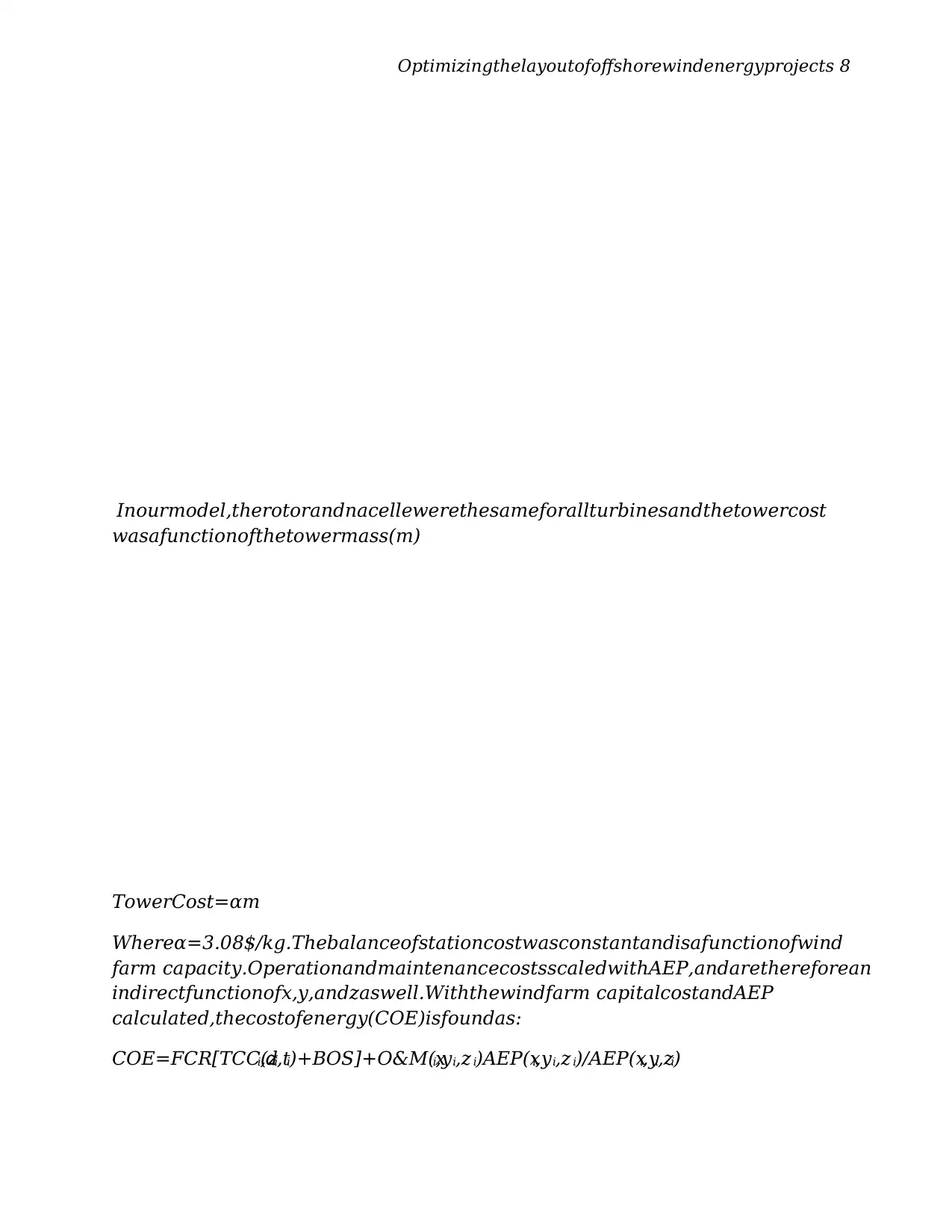
Optimizingthelayoutofoffshorewindenergyprojects 8
Inourmodel,therotorandnacellewerethesameforallturbinesandthetowercost
wasafunctionofthetowermass(m)
TowerCost=αm
Whereα=3.08$/kg.Thebalanceofstationcostwasconstantandisafunctionofwind
farm capacity.OperationandmaintenancecostsscaledwithAEP,andarethereforean
indirectfunctionofx,y,andzaswell.Withthewindfarm capitalcostandAEP
calculated,thecostofenergy(COE)isfoundas:
COE=FCR[TCC(zi,di,ti)+BOS]+O&M(xi,yi,z i)AEP(xi,yi,z i)/AEP(xi,yi,zi)
Inourmodel,therotorandnacellewerethesameforallturbinesandthetowercost
wasafunctionofthetowermass(m)
TowerCost=αm
Whereα=3.08$/kg.Thebalanceofstationcostwasconstantandisafunctionofwind
farm capacity.OperationandmaintenancecostsscaledwithAEP,andarethereforean
indirectfunctionofx,y,andzaswell.Withthewindfarm capitalcostandAEP
calculated,thecostofenergy(COE)isfoundas:
COE=FCR[TCC(zi,di,ti)+BOS]+O&M(xi,yi,z i)AEP(xi,yi,z i)/AEP(xi,yi,zi)
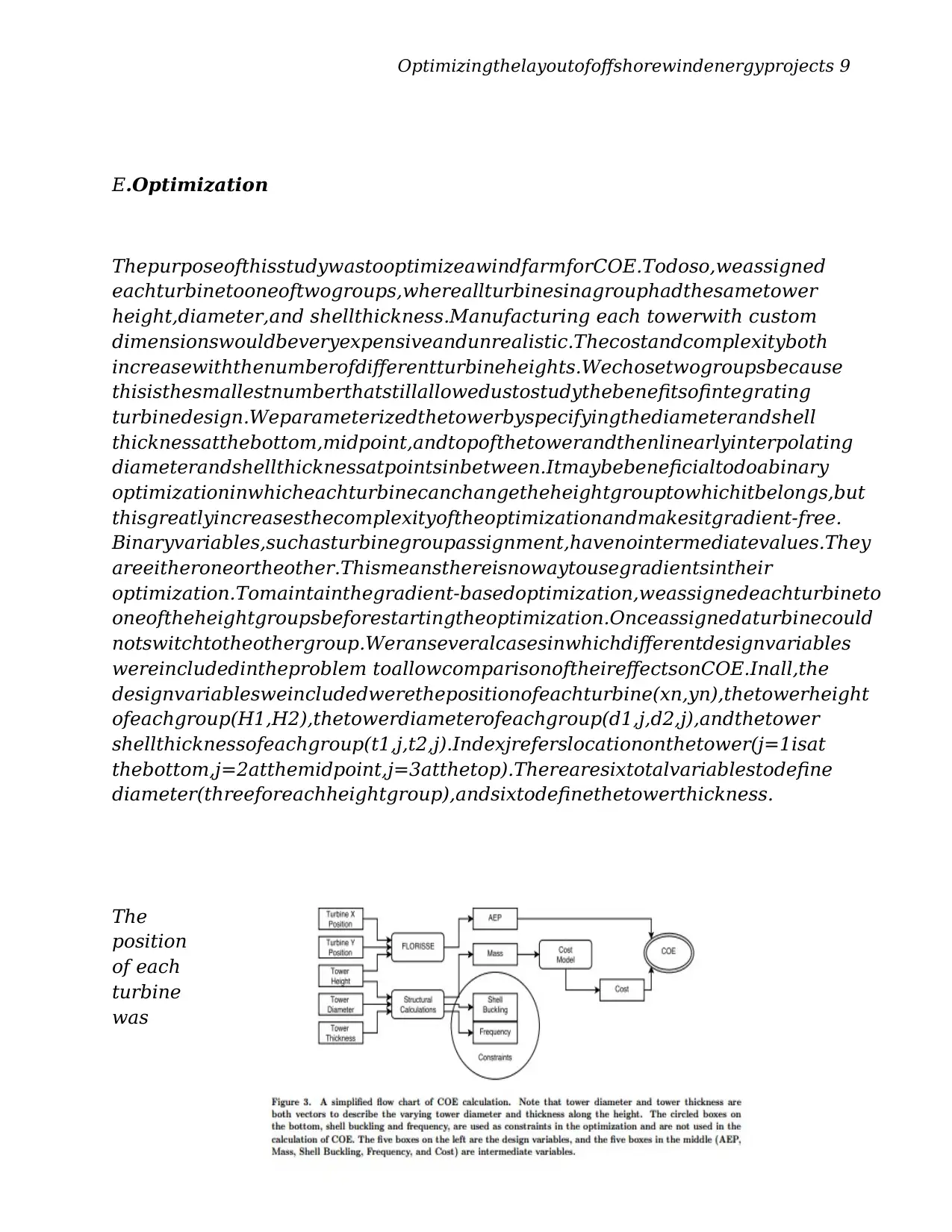
Optimizingthelayoutofoffshorewindenergyprojects 9
E.Optimization
ThepurposeofthisstudywastooptimizeawindfarmforCOE.Todoso,weassigned
eachturbinetooneoftwogroups,whereallturbinesinagrouphadthesametower
height,diameter,and shellthickness.Manufacturing each towerwith custom
dimensionswouldbeveryexpensiveandunrealistic.Thecostandcomplexityboth
increasewiththenumberofdifferentturbineheights.Wechosetwogroupsbecause
thisisthesmallestnumberthatstillallowedustostudythebenefitsofintegrating
turbinedesign.Weparameterizedthetowerbyspecifyingthediameterandshell
thicknessatthebottom,midpoint,andtopofthetowerandthenlinearlyinterpolating
diameterandshellthicknessatpointsinbetween.Itmaybebeneficialtodoabinary
optimizationinwhicheachturbinecanchangetheheightgrouptowhichitbelongs,but
thisgreatlyincreasesthecomplexityoftheoptimizationandmakesitgradient-free.
Binaryvariables,suchasturbinegroupassignment,havenointermediatevalues.They
areeitheroneortheother.Thismeansthereisnowaytousegradientsintheir
optimization.Tomaintainthegradient-basedoptimization,weassignedeachturbineto
oneoftheheightgroupsbeforestartingtheoptimization.Onceassignedaturbinecould
notswitchtotheothergroup.Weranseveralcasesinwhichdifferentdesignvariables
wereincludedintheproblem toallowcomparisonoftheireffectsonCOE.Inall,the
designvariablesweincludedwerethepositionofeachturbine(xn,yn),thetowerheight
ofeachgroup(H1,H2),thetowerdiameterofeachgroup(d1,j,d2,j),andthetower
shellthicknessofeachgroup(t1,j,t2,j).Indexjreferslocationonthetower(j=1isat
thebottom,j=2atthemidpoint,j=3atthetop).Therearesixtotalvariablestodefine
diameter(threeforeachheightgroup),andsixtodefinethetowerthickness.
The
position
of each
turbine
was
E.Optimization
ThepurposeofthisstudywastooptimizeawindfarmforCOE.Todoso,weassigned
eachturbinetooneoftwogroups,whereallturbinesinagrouphadthesametower
height,diameter,and shellthickness.Manufacturing each towerwith custom
dimensionswouldbeveryexpensiveandunrealistic.Thecostandcomplexityboth
increasewiththenumberofdifferentturbineheights.Wechosetwogroupsbecause
thisisthesmallestnumberthatstillallowedustostudythebenefitsofintegrating
turbinedesign.Weparameterizedthetowerbyspecifyingthediameterandshell
thicknessatthebottom,midpoint,andtopofthetowerandthenlinearlyinterpolating
diameterandshellthicknessatpointsinbetween.Itmaybebeneficialtodoabinary
optimizationinwhicheachturbinecanchangetheheightgrouptowhichitbelongs,but
thisgreatlyincreasesthecomplexityoftheoptimizationandmakesitgradient-free.
Binaryvariables,suchasturbinegroupassignment,havenointermediatevalues.They
areeitheroneortheother.Thismeansthereisnowaytousegradientsintheir
optimization.Tomaintainthegradient-basedoptimization,weassignedeachturbineto
oneoftheheightgroupsbeforestartingtheoptimization.Onceassignedaturbinecould
notswitchtotheothergroup.Weranseveralcasesinwhichdifferentdesignvariables
wereincludedintheproblem toallowcomparisonoftheireffectsonCOE.Inall,the
designvariablesweincludedwerethepositionofeachturbine(xn,yn),thetowerheight
ofeachgroup(H1,H2),thetowerdiameterofeachgroup(d1,j,d2,j),andthetower
shellthicknessofeachgroup(t1,j,t2,j).Indexjreferslocationonthetower(j=1isat
thebottom,j=2atthemidpoint,j=3atthetop).Therearesixtotalvariablestodefine
diameter(threeforeachheightgroup),andsixtodefinethetowerthickness.
The
position
of each
turbine
was
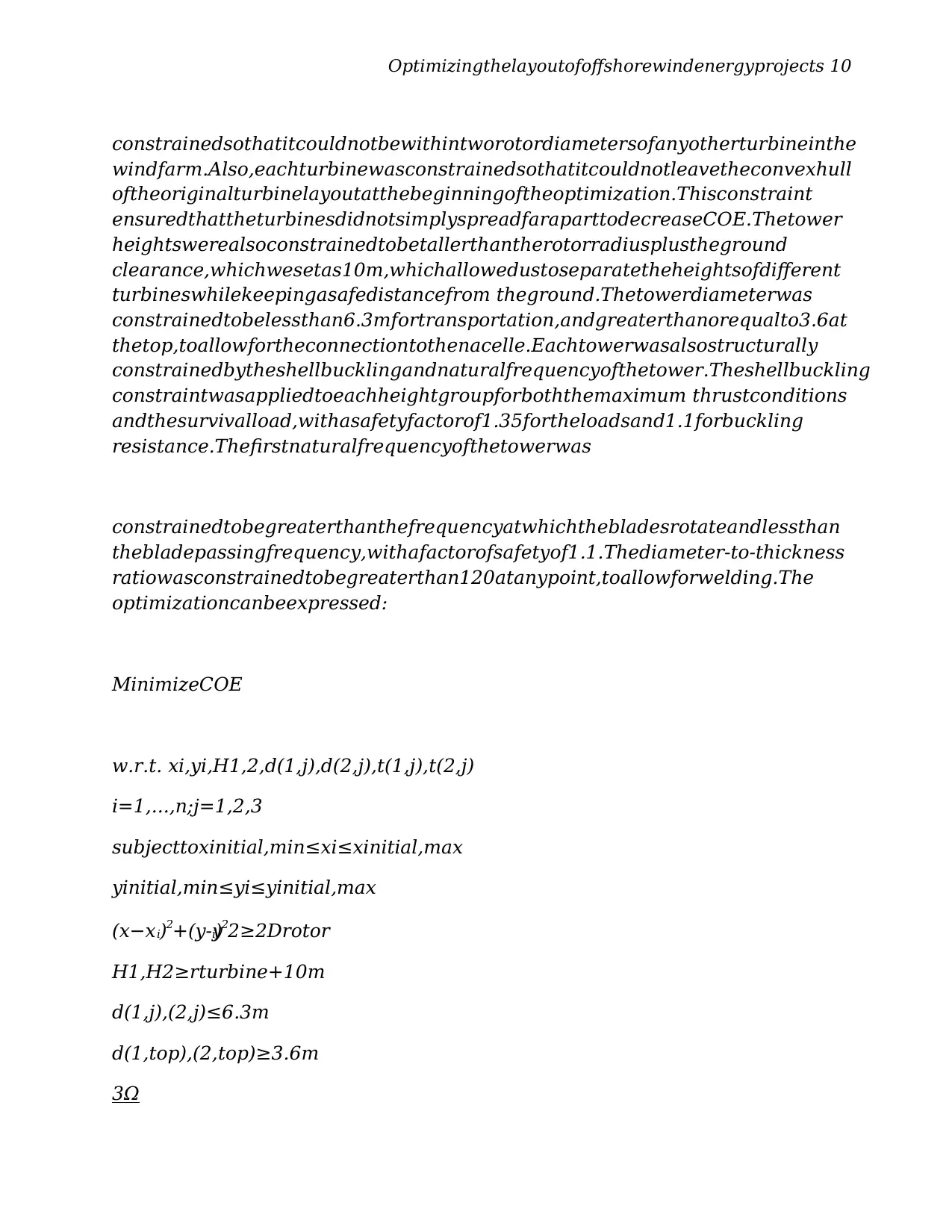
Optimizingthelayoutofoffshorewindenergyprojects 10
constrainedsothatitcouldnotbewithintworotordiametersofanyotherturbineinthe
windfarm.Also,eachturbinewasconstrainedsothatitcouldnotleavetheconvexhull
oftheoriginalturbinelayoutatthebeginningoftheoptimization.Thisconstraint
ensuredthattheturbinesdidnotsimplyspreadfaraparttodecreaseCOE.Thetower
heightswerealsoconstrainedtobetallerthantherotorradiusplustheground
clearance,whichwesetas10m,whichallowedustoseparatetheheightsofdifferent
turbineswhilekeepingasafedistancefrom theground.Thetowerdiameterwas
constrainedtobelessthan6.3mfortransportation,andgreaterthanorequalto3.6at
thetop,toallowfortheconnectiontothenacelle.Eachtowerwasalsostructurally
constrainedbytheshellbucklingandnaturalfrequencyofthetower.Theshellbuckling
constraintwasappliedtoeachheightgroupforboththemaximum thrustconditions
andthesurvivalload,withasafetyfactorof1.35fortheloadsand1.1forbuckling
resistance.Thefirstnaturalfrequencyofthetowerwas
constrainedtobegreaterthanthefrequencyatwhichthebladesrotateandlessthan
thebladepassingfrequency,withafactorofsafetyof1.1.Thediameter-to-thickness
ratiowasconstrainedtobegreaterthan120atanypoint,toallowforwelding.The
optimizationcanbeexpressed:
MinimizeCOE
w.r.t. xi,yi,H1,2,d(1,j),d(2,j),t(1,j),t(2,j)
i=1,...,n;j=1,2,3
subjecttoxinitial,min≤xi≤xinitial,max
yinitial,min≤yi≤yinitial,max
(x−xi)2+(y-yi)22≥2Drotor
H1,H2≥rturbine+10m
d(1,j),(2,j)≤6.3m
d(1,top),(2,top)≥3.6m
3Ω
constrainedsothatitcouldnotbewithintworotordiametersofanyotherturbineinthe
windfarm.Also,eachturbinewasconstrainedsothatitcouldnotleavetheconvexhull
oftheoriginalturbinelayoutatthebeginningoftheoptimization.Thisconstraint
ensuredthattheturbinesdidnotsimplyspreadfaraparttodecreaseCOE.Thetower
heightswerealsoconstrainedtobetallerthantherotorradiusplustheground
clearance,whichwesetas10m,whichallowedustoseparatetheheightsofdifferent
turbineswhilekeepingasafedistancefrom theground.Thetowerdiameterwas
constrainedtobelessthan6.3mfortransportation,andgreaterthanorequalto3.6at
thetop,toallowfortheconnectiontothenacelle.Eachtowerwasalsostructurally
constrainedbytheshellbucklingandnaturalfrequencyofthetower.Theshellbuckling
constraintwasappliedtoeachheightgroupforboththemaximum thrustconditions
andthesurvivalload,withasafetyfactorof1.35fortheloadsand1.1forbuckling
resistance.Thefirstnaturalfrequencyofthetowerwas
constrainedtobegreaterthanthefrequencyatwhichthebladesrotateandlessthan
thebladepassingfrequency,withafactorofsafetyof1.1.Thediameter-to-thickness
ratiowasconstrainedtobegreaterthan120atanypoint,toallowforwelding.The
optimizationcanbeexpressed:
MinimizeCOE
w.r.t. xi,yi,H1,2,d(1,j),d(2,j),t(1,j),t(2,j)
i=1,...,n;j=1,2,3
subjecttoxinitial,min≤xi≤xinitial,max
yinitial,min≤yi≤yinitial,max
(x−xi)2+(y-yi)22≥2Drotor
H1,H2≥rturbine+10m
d(1,j),(2,j)≤6.3m
d(1,top),(2,top)≥3.6m
3Ω
Paraphrase This Document
Need a fresh take? Get an instant paraphrase of this document with our AI Paraphraser
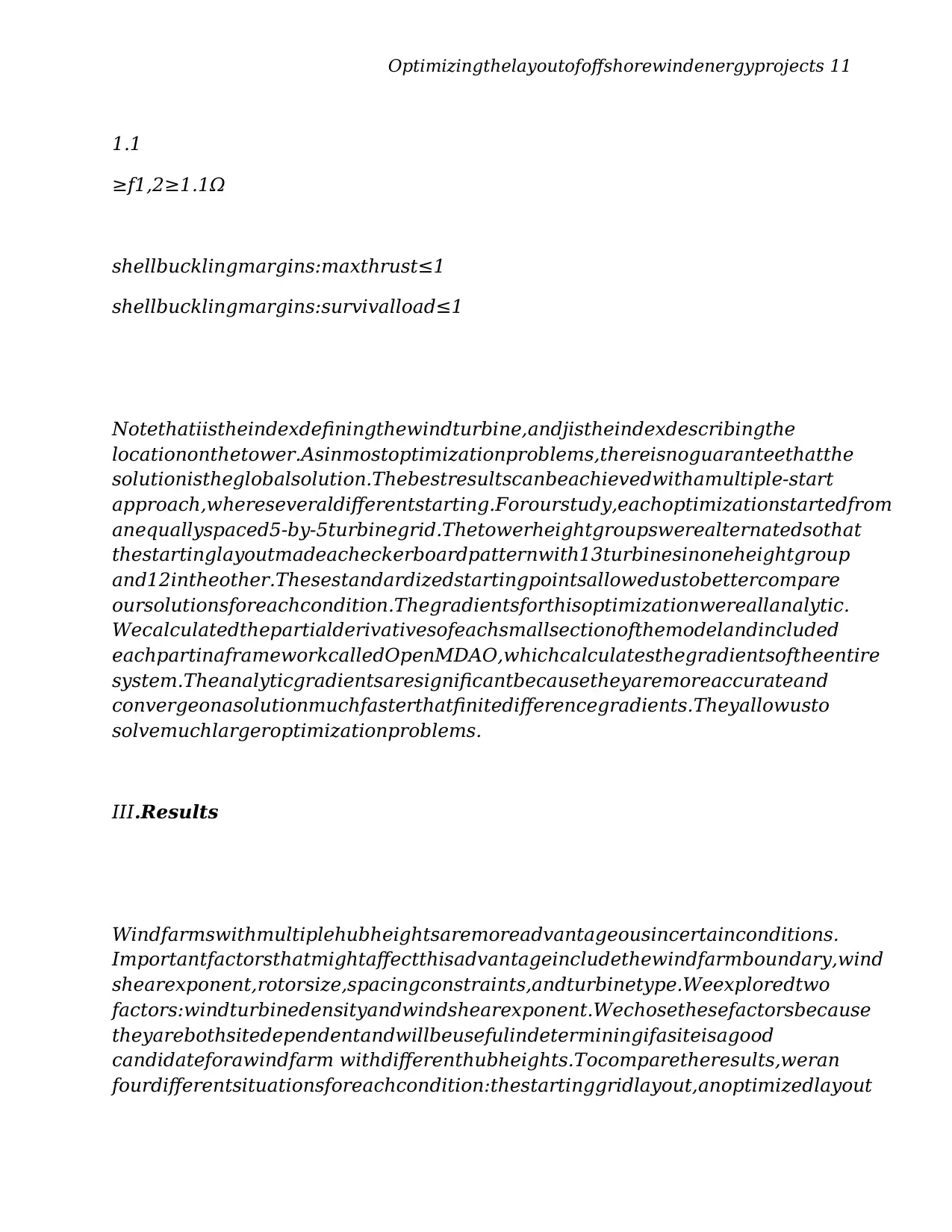
Optimizingthelayoutofoffshorewindenergyprojects 11
1.1
≥f1,2≥1.1Ω
shellbucklingmargins:maxthrust≤1
shellbucklingmargins:survivalload≤1
Notethatiistheindexdefiningthewindturbine,andjistheindexdescribingthe
locationonthetower.Asinmostoptimizationproblems,thereisnoguaranteethatthe
solutionistheglobalsolution.Thebestresultscanbeachievedwithamultiple-start
approach,whereseveraldifferentstarting.Forourstudy,eachoptimizationstartedfrom
anequallyspaced5-by-5turbinegrid.Thetowerheightgroupswerealternatedsothat
thestartinglayoutmadeacheckerboardpatternwith13turbinesinoneheightgroup
and12intheother.Thesestandardizedstartingpointsallowedustobettercompare
oursolutionsforeachcondition.Thegradientsforthisoptimizationwereallanalytic.
Wecalculatedthepartialderivativesofeachsmallsectionofthemodelandincluded
eachpartinaframeworkcalledOpenMDAO,whichcalculatesthegradientsoftheentire
system.Theanalyticgradientsaresignificantbecausetheyaremoreaccurateand
convergeonasolutionmuchfasterthatfinitedifferencegradients.Theyallowusto
solvemuchlargeroptimizationproblems.
III.Results
Windfarmswithmultiplehubheightsaremoreadvantageousincertainconditions.
Importantfactorsthatmightaffectthisadvantageincludethewindfarmboundary,wind
shearexponent,rotorsize,spacingconstraints,andturbinetype.Weexploredtwo
factors:windturbinedensityandwindshearexponent.Wechosethesefactorsbecause
theyarebothsitedependentandwillbeusefulindeterminingifasiteisagood
candidateforawindfarm withdifferenthubheights.Tocomparetheresults,weran
fourdifferentsituationsforeachcondition:thestartinggridlayout,anoptimizedlayout
1.1
≥f1,2≥1.1Ω
shellbucklingmargins:maxthrust≤1
shellbucklingmargins:survivalload≤1
Notethatiistheindexdefiningthewindturbine,andjistheindexdescribingthe
locationonthetower.Asinmostoptimizationproblems,thereisnoguaranteethatthe
solutionistheglobalsolution.Thebestresultscanbeachievedwithamultiple-start
approach,whereseveraldifferentstarting.Forourstudy,eachoptimizationstartedfrom
anequallyspaced5-by-5turbinegrid.Thetowerheightgroupswerealternatedsothat
thestartinglayoutmadeacheckerboardpatternwith13turbinesinoneheightgroup
and12intheother.Thesestandardizedstartingpointsallowedustobettercompare
oursolutionsforeachcondition.Thegradientsforthisoptimizationwereallanalytic.
Wecalculatedthepartialderivativesofeachsmallsectionofthemodelandincluded
eachpartinaframeworkcalledOpenMDAO,whichcalculatesthegradientsoftheentire
system.Theanalyticgradientsaresignificantbecausetheyaremoreaccurateand
convergeonasolutionmuchfasterthatfinitedifferencegradients.Theyallowusto
solvemuchlargeroptimizationproblems.
III.Results
Windfarmswithmultiplehubheightsaremoreadvantageousincertainconditions.
Importantfactorsthatmightaffectthisadvantageincludethewindfarmboundary,wind
shearexponent,rotorsize,spacingconstraints,andturbinetype.Weexploredtwo
factors:windturbinedensityandwindshearexponent.Wechosethesefactorsbecause
theyarebothsitedependentandwillbeusefulindeterminingifasiteisagood
candidateforawindfarm withdifferenthubheights.Tocomparetheresults,weran
fourdifferentsituationsforeachcondition:thestartinggridlayout,anoptimizedlayout
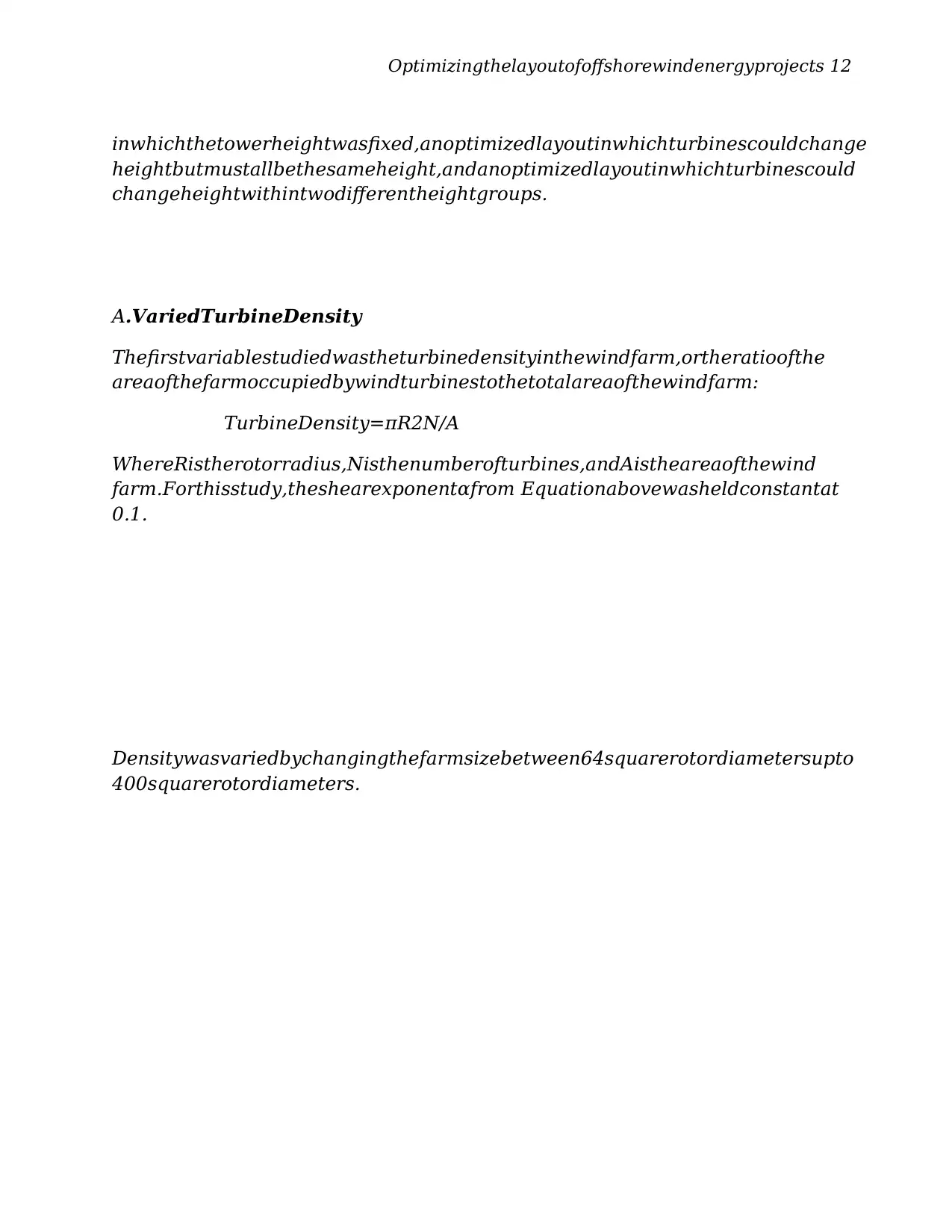
Optimizingthelayoutofoffshorewindenergyprojects 12
inwhichthetowerheightwasfixed,anoptimizedlayoutinwhichturbinescouldchange
heightbutmustallbethesameheight,andanoptimizedlayoutinwhichturbinescould
changeheightwithintwodifferentheightgroups.
A.VariedTurbineDensity
Thefirstvariablestudiedwastheturbinedensityinthewindfarm,ortheratioofthe
areaofthefarmoccupiedbywindturbinestothetotalareaofthewindfarm:
TurbineDensity=πR2N/A
WhereRistherotorradius,Nisthenumberofturbines,andAistheareaofthewind
farm.Forthisstudy,theshearexponentαfrom Equationabovewasheldconstantat
0.1.
Densitywasvariedbychangingthefarmsizebetween64squarerotordiametersupto
400squarerotordiameters.
inwhichthetowerheightwasfixed,anoptimizedlayoutinwhichturbinescouldchange
heightbutmustallbethesameheight,andanoptimizedlayoutinwhichturbinescould
changeheightwithintwodifferentheightgroups.
A.VariedTurbineDensity
Thefirstvariablestudiedwastheturbinedensityinthewindfarm,ortheratioofthe
areaofthefarmoccupiedbywindturbinestothetotalareaofthewindfarm:
TurbineDensity=πR2N/A
WhereRistherotorradius,Nisthenumberofturbines,andAistheareaofthewind
farm.Forthisstudy,theshearexponentαfrom Equationabovewasheldconstantat
0.1.
Densitywasvariedbychangingthefarmsizebetween64squarerotordiametersupto
400squarerotordiameters.

Optimizingthelayoutofoffshorewindenergyprojects 13
Figure4(a)showsanoptimizedwindfarmlayoutwithlowturbinedensity.Thedifferent
colorscorrespondtothedifferentheightgroupsshowninFig.4(b).Figure4(c)andFig.
4(d)alsoshowanoptimizedwindfarm andthecorrespondingturbineheights,butfor
thecaseofhighturbinedensity.InFig.4(a),forthecaseoflowturbinedensity,the
turbinesareveryfarapart,andcaneasilymovehorizontally.Thus,weseeinFig.4(b)
thattheoptimizedheightsarethesame.ThehighdensitycaseFig.4(c)isnotableto
moveasmuchhorizontally,soithaslowerCOEbyseparatingthetwoheightgroups
showninFig.4(d).Figure5showstheCOEoptimizedforeachwindfarm undereach
conditionpreviouslydiscussed.Thecyanpointsatthetoprepresentthefarmsthat
havenotbeenoptimizedandtheblackpointsarethefarmsthathavebeenoptimized
forlayout.Theredpointshavebeenoptimizedforlayoutandheight(thereisonlyone
heightgroup),andthebluepointshavebeenoptimizedforlayoutandheight,wheretwo
differentheightgroupsareallowed.LowturbinedensitylogicallyresultsinlowCOE
becausetheturbinesremainfarapartandwakeeffectsarenotashigh(SeeFig.4(a)).
Figure4(a)showsanoptimizedwindfarmlayoutwithlowturbinedensity.Thedifferent
colorscorrespondtothedifferentheightgroupsshowninFig.4(b).Figure4(c)andFig.
4(d)alsoshowanoptimizedwindfarm andthecorrespondingturbineheights,butfor
thecaseofhighturbinedensity.InFig.4(a),forthecaseoflowturbinedensity,the
turbinesareveryfarapart,andcaneasilymovehorizontally.Thus,weseeinFig.4(b)
thattheoptimizedheightsarethesame.ThehighdensitycaseFig.4(c)isnotableto
moveasmuchhorizontally,soithaslowerCOEbyseparatingthetwoheightgroups
showninFig.4(d).Figure5showstheCOEoptimizedforeachwindfarm undereach
conditionpreviouslydiscussed.Thecyanpointsatthetoprepresentthefarmsthat
havenotbeenoptimizedandtheblackpointsarethefarmsthathavebeenoptimized
forlayout.Theredpointshavebeenoptimizedforlayoutandheight(thereisonlyone
heightgroup),andthebluepointshavebeenoptimizedforlayoutandheight,wheretwo
differentheightgroupsareallowed.LowturbinedensitylogicallyresultsinlowCOE
becausetheturbinesremainfarapartandwakeeffectsarenotashigh(SeeFig.4(a)).
Secure Best Marks with AI Grader
Need help grading? Try our AI Grader for instant feedback on your assignments.
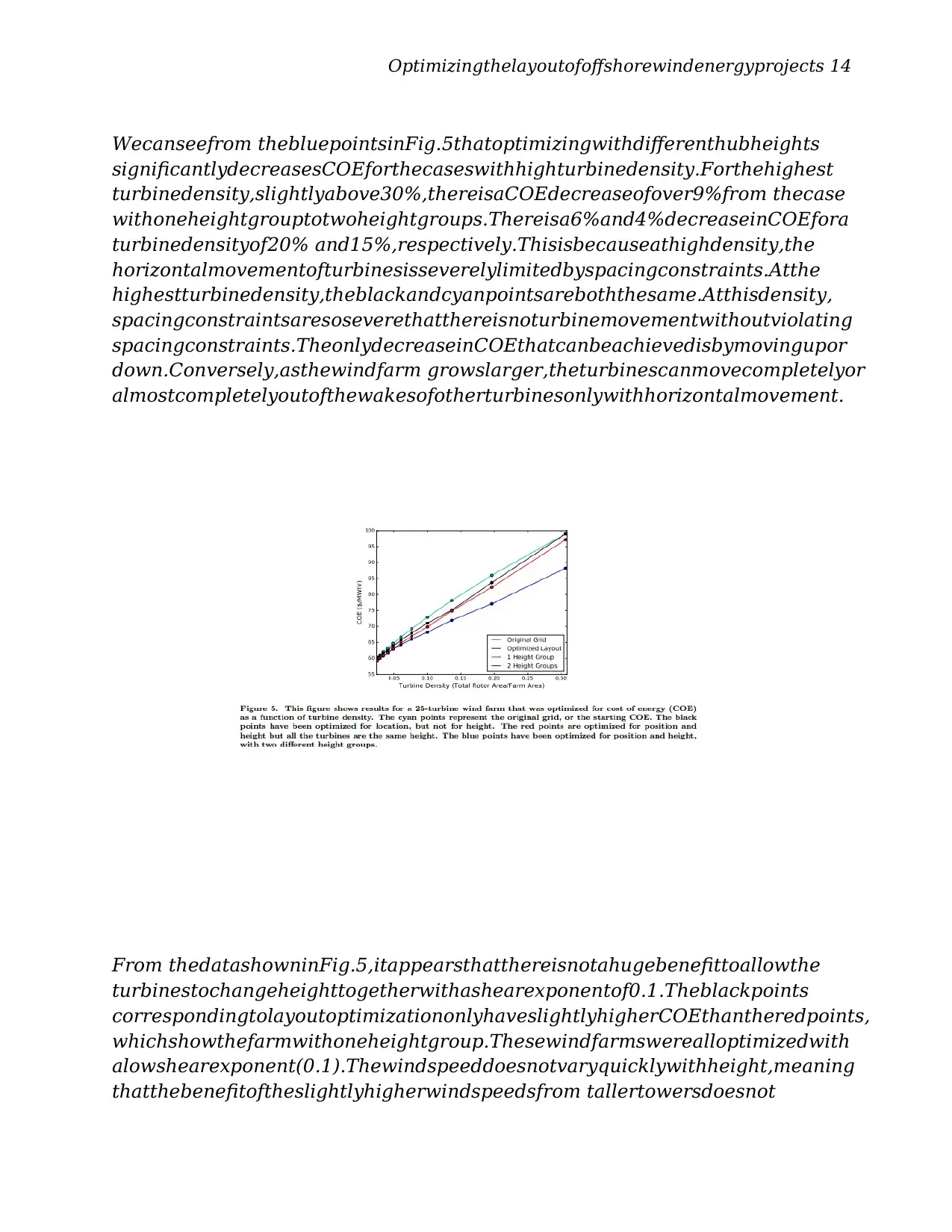
Optimizingthelayoutofoffshorewindenergyprojects 14
Wecanseefrom thebluepointsinFig.5thatoptimizingwithdifferenthubheights
significantlydecreasesCOEforthecaseswithhighturbinedensity.Forthehighest
turbinedensity,slightlyabove30%,thereisaCOEdecreaseofover9%from thecase
withoneheightgrouptotwoheightgroups.Thereisa6%and4%decreaseinCOEfora
turbinedensityof20% and15%,respectively.Thisisbecauseathighdensity,the
horizontalmovementofturbinesisseverelylimitedbyspacingconstraints.Atthe
highestturbinedensity,theblackandcyanpointsareboththesame.Atthisdensity,
spacingconstraintsaresoseverethatthereisnoturbinemovementwithoutviolating
spacingconstraints.TheonlydecreaseinCOEthatcanbeachievedisbymovingupor
down.Conversely,asthewindfarm growslarger,theturbinescanmovecompletelyor
almostcompletelyoutofthewakesofotherturbinesonlywithhorizontalmovement.
From thedatashowninFig.5,itappearsthatthereisnotahugebenefittoallowthe
turbinestochangeheighttogetherwithashearexponentof0.1.Theblackpoints
correspondingtolayoutoptimizationonlyhaveslightlyhigherCOEthantheredpoints,
whichshowthefarmwithoneheightgroup.Thesewindfarmswerealloptimizedwith
alowshearexponent(0.1).Thewindspeeddoesnotvaryquicklywithheight,meaning
thatthebenefitoftheslightlyhigherwindspeedsfrom tallertowersdoesnot
Wecanseefrom thebluepointsinFig.5thatoptimizingwithdifferenthubheights
significantlydecreasesCOEforthecaseswithhighturbinedensity.Forthehighest
turbinedensity,slightlyabove30%,thereisaCOEdecreaseofover9%from thecase
withoneheightgrouptotwoheightgroups.Thereisa6%and4%decreaseinCOEfora
turbinedensityof20% and15%,respectively.Thisisbecauseathighdensity,the
horizontalmovementofturbinesisseverelylimitedbyspacingconstraints.Atthe
highestturbinedensity,theblackandcyanpointsareboththesame.Atthisdensity,
spacingconstraintsaresoseverethatthereisnoturbinemovementwithoutviolating
spacingconstraints.TheonlydecreaseinCOEthatcanbeachievedisbymovingupor
down.Conversely,asthewindfarm growslarger,theturbinescanmovecompletelyor
almostcompletelyoutofthewakesofotherturbinesonlywithhorizontalmovement.
From thedatashowninFig.5,itappearsthatthereisnotahugebenefittoallowthe
turbinestochangeheighttogetherwithashearexponentof0.1.Theblackpoints
correspondingtolayoutoptimizationonlyhaveslightlyhigherCOEthantheredpoints,
whichshowthefarmwithoneheightgroup.Thesewindfarmswerealloptimizedwith
alowshearexponent(0.1).Thewindspeeddoesnotvaryquicklywithheight,meaning
thatthebenefitoftheslightlyhigherwindspeedsfrom tallertowersdoesnot

Optimizingthelayoutofoffshorewindenergyprojects 15
significantlyoutweightheadditionalcostoflargertowers.Figure6showsthetower
heightforeachoftheheightgroupsasafunctionofturbinedensity.Thisonlyappliesto
thecaseinwhichtherewereonlytwodifferentheightgroups.Thecolorsarethesame
asinFig.4.Asshown,whentheturbinesaretightlypacked(densityhigherthan5%),the
optimizervariedtheheightssignificantlytominimizeCOE.
Anyfarmwithalowerdensitydoesnotbenefitfromdifferenttowerheights.Noticethat
whenalltheheightsarethesame,theyarenotatthemaximum height.Theshear
exponent,0.1,doesnotresultinhighenoughwindspeedstomakeitworththecostof
buildinglargerturbines.
significantlyoutweightheadditionalcostoflargertowers.Figure6showsthetower
heightforeachoftheheightgroupsasafunctionofturbinedensity.Thisonlyappliesto
thecaseinwhichtherewereonlytwodifferentheightgroups.Thecolorsarethesame
asinFig.4.Asshown,whentheturbinesaretightlypacked(densityhigherthan5%),the
optimizervariedtheheightssignificantlytominimizeCOE.
Anyfarmwithalowerdensitydoesnotbenefitfromdifferenttowerheights.Noticethat
whenalltheheightsarethesame,theyarenotatthemaximum height.Theshear
exponent,0.1,doesnotresultinhighenoughwindspeedstomakeitworththecostof
buildinglargerturbines.
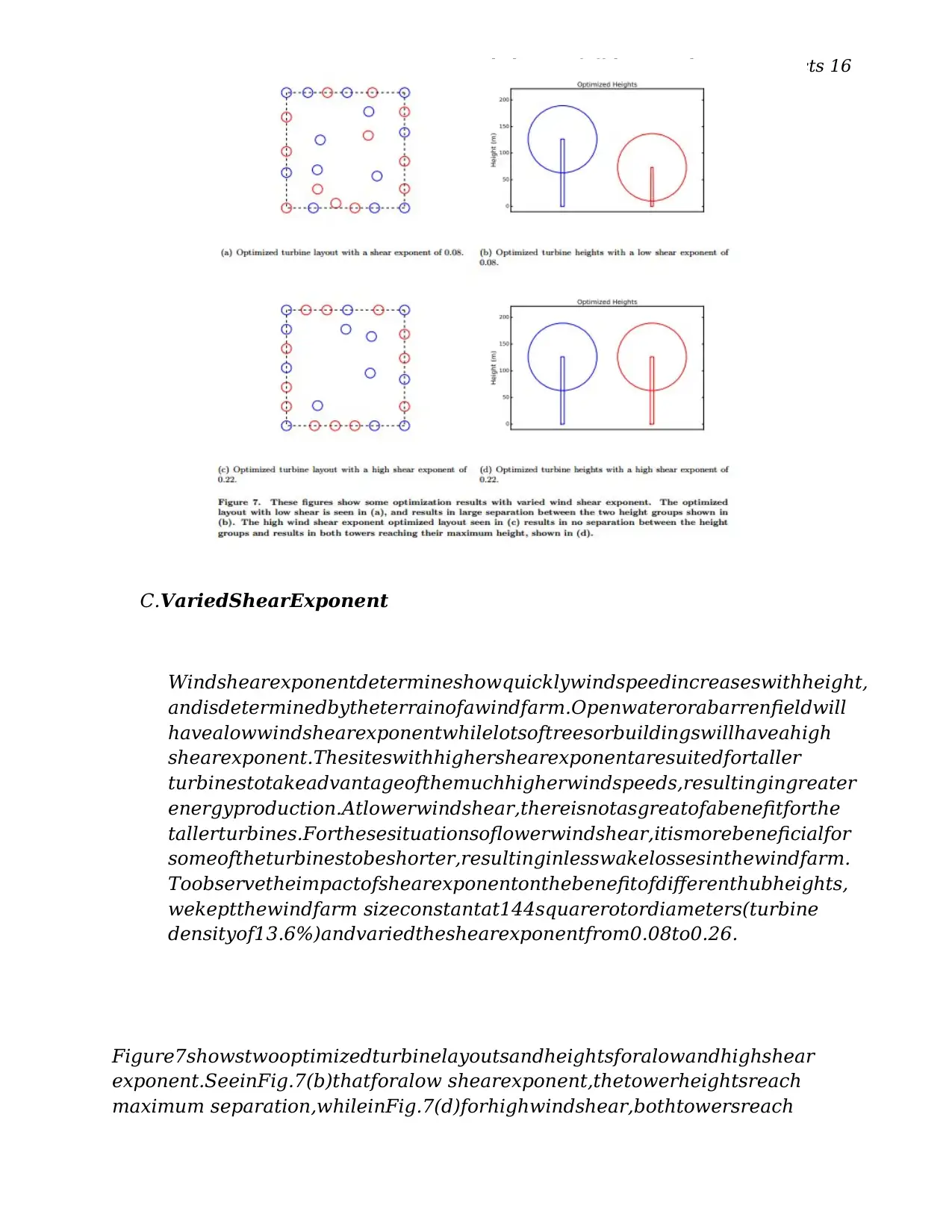
Optimizingthelayoutofoffshorewindenergyprojects 16
C.VariedShearExponent
Windshearexponentdetermineshowquicklywindspeedincreaseswithheight,
andisdeterminedbytheterrainofawindfarm.Openwaterorabarrenfieldwill
havealowwindshearexponentwhilelotsoftreesorbuildingswillhaveahigh
shearexponent.Thesiteswithhighershearexponentaresuitedfortaller
turbinestotakeadvantageofthemuchhigherwindspeeds,resultingingreater
energyproduction.Atlowerwindshear,thereisnotasgreatofabenefitforthe
tallerturbines.Forthesesituationsoflowerwindshear,itismorebeneficialfor
someoftheturbinestobeshorter,resultinginlesswakelossesinthewindfarm.
Toobservetheimpactofshearexponentonthebenefitofdifferenthubheights,
wekeptthewindfarm sizeconstantat144squarerotordiameters(turbine
densityof13.6%)andvariedtheshearexponentfrom0.08to0.26.
Figure7showstwooptimizedturbinelayoutsandheightsforalowandhighshear
exponent.SeeinFig.7(b)thatforalow shearexponent,thetowerheightsreach
maximum separation,whileinFig.7(d)forhighwindshear,bothtowersreach
C.VariedShearExponent
Windshearexponentdetermineshowquicklywindspeedincreaseswithheight,
andisdeterminedbytheterrainofawindfarm.Openwaterorabarrenfieldwill
havealowwindshearexponentwhilelotsoftreesorbuildingswillhaveahigh
shearexponent.Thesiteswithhighershearexponentaresuitedfortaller
turbinestotakeadvantageofthemuchhigherwindspeeds,resultingingreater
energyproduction.Atlowerwindshear,thereisnotasgreatofabenefitforthe
tallerturbines.Forthesesituationsoflowerwindshear,itismorebeneficialfor
someoftheturbinestobeshorter,resultinginlesswakelossesinthewindfarm.
Toobservetheimpactofshearexponentonthebenefitofdifferenthubheights,
wekeptthewindfarm sizeconstantat144squarerotordiameters(turbine
densityof13.6%)andvariedtheshearexponentfrom0.08to0.26.
Figure7showstwooptimizedturbinelayoutsandheightsforalowandhighshear
exponent.SeeinFig.7(b)thatforalow shearexponent,thetowerheightsreach
maximum separation,whileinFig.7(d)forhighwindshear,bothtowersreach
Paraphrase This Document
Need a fresh take? Get an instant paraphrase of this document with our AI Paraphraser
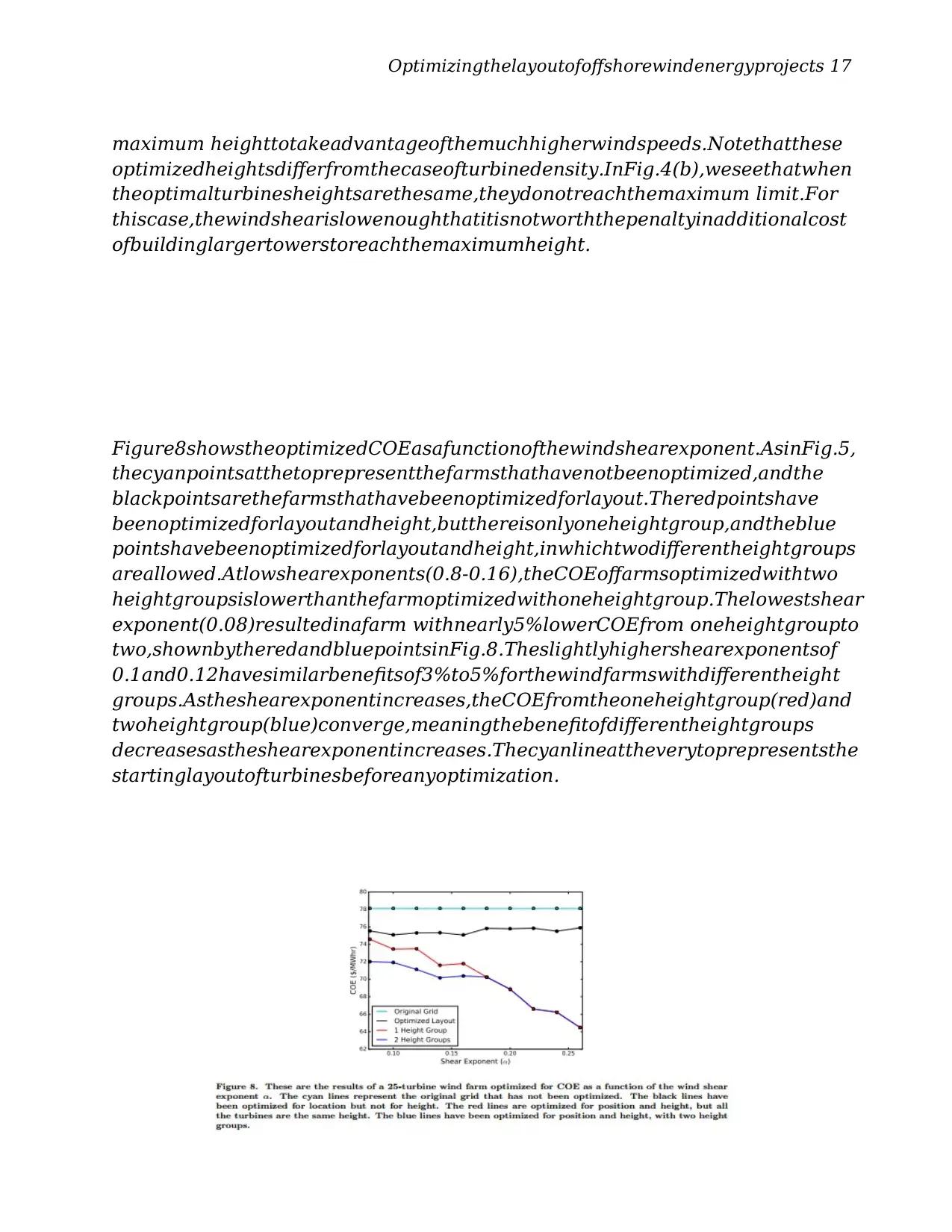
Optimizingthelayoutofoffshorewindenergyprojects 17
maximum heighttotakeadvantageofthemuchhigherwindspeeds.Notethatthese
optimizedheightsdifferfromthecaseofturbinedensity.InFig.4(b),weseethatwhen
theoptimalturbinesheightsarethesame,theydonotreachthemaximum limit.For
thiscase,thewindshearislowenoughthatitisnotworththepenaltyinadditionalcost
ofbuildinglargertowerstoreachthemaximumheight.
Figure8showstheoptimizedCOEasafunctionofthewindshearexponent.AsinFig.5,
thecyanpointsatthetoprepresentthefarmsthathavenotbeenoptimized,andthe
blackpointsarethefarmsthathavebeenoptimizedforlayout.Theredpointshave
beenoptimizedforlayoutandheight,butthereisonlyoneheightgroup,andtheblue
pointshavebeenoptimizedforlayoutandheight,inwhichtwodifferentheightgroups
areallowed.Atlowshearexponents(0.8-0.16),theCOEoffarmsoptimizedwithtwo
heightgroupsislowerthanthefarmoptimizedwithoneheightgroup.Thelowestshear
exponent(0.08)resultedinafarm withnearly5%lowerCOEfrom oneheightgroupto
two,shownbytheredandbluepointsinFig.8.Theslightlyhighershearexponentsof
0.1and0.12havesimilarbenefitsof3%to5%forthewindfarmswithdifferentheight
groups.Astheshearexponentincreases,theCOEfromtheoneheightgroup(red)and
twoheightgroup(blue)converge,meaningthebenefitofdifferentheightgroups
decreasesastheshearexponentincreases.Thecyanlineattheverytoprepresentsthe
startinglayoutofturbinesbeforeanyoptimization.
maximum heighttotakeadvantageofthemuchhigherwindspeeds.Notethatthese
optimizedheightsdifferfromthecaseofturbinedensity.InFig.4(b),weseethatwhen
theoptimalturbinesheightsarethesame,theydonotreachthemaximum limit.For
thiscase,thewindshearislowenoughthatitisnotworththepenaltyinadditionalcost
ofbuildinglargertowerstoreachthemaximumheight.
Figure8showstheoptimizedCOEasafunctionofthewindshearexponent.AsinFig.5,
thecyanpointsatthetoprepresentthefarmsthathavenotbeenoptimized,andthe
blackpointsarethefarmsthathavebeenoptimizedforlayout.Theredpointshave
beenoptimizedforlayoutandheight,butthereisonlyoneheightgroup,andtheblue
pointshavebeenoptimizedforlayoutandheight,inwhichtwodifferentheightgroups
areallowed.Atlowshearexponents(0.8-0.16),theCOEoffarmsoptimizedwithtwo
heightgroupsislowerthanthefarmoptimizedwithoneheightgroup.Thelowestshear
exponent(0.08)resultedinafarm withnearly5%lowerCOEfrom oneheightgroupto
two,shownbytheredandbluepointsinFig.8.Theslightlyhighershearexponentsof
0.1and0.12havesimilarbenefitsof3%to5%forthewindfarmswithdifferentheight
groups.Astheshearexponentincreases,theCOEfromtheoneheightgroup(red)and
twoheightgroup(blue)converge,meaningthebenefitofdifferentheightgroups
decreasesastheshearexponentincreases.Thecyanlineattheverytoprepresentsthe
startinglayoutofturbinesbeforeanyoptimization.
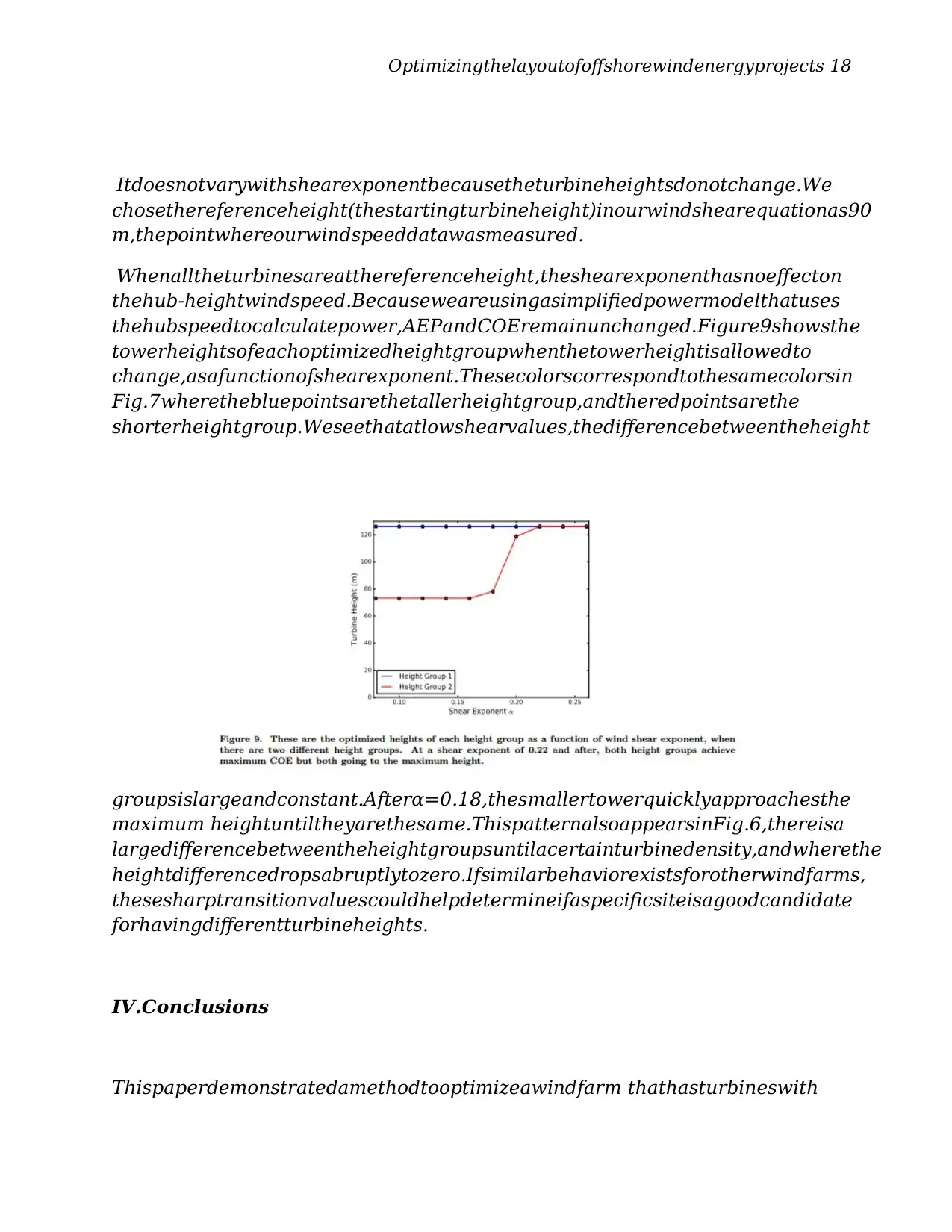
Optimizingthelayoutofoffshorewindenergyprojects 18
Itdoesnotvarywithshearexponentbecausetheturbineheightsdonotchange.We
chosethereferenceheight(thestartingturbineheight)inourwindshearequationas90
m,thepointwhereourwindspeeddatawasmeasured.
Whenalltheturbinesareatthereferenceheight,theshearexponenthasnoeffecton
thehub-heightwindspeed.Becauseweareusingasimplifiedpowermodelthatuses
thehubspeedtocalculatepower,AEPandCOEremainunchanged.Figure9showsthe
towerheightsofeachoptimizedheightgroupwhenthetowerheightisallowedto
change,asafunctionofshearexponent.Thesecolorscorrespondtothesamecolorsin
Fig.7wherethebluepointsarethetallerheightgroup,andtheredpointsarethe
shorterheightgroup.Weseethatatlowshearvalues,thedifferencebetweentheheight
groupsislargeandconstant.Afterα=0.18,thesmallertowerquicklyapproachesthe
maximum heightuntiltheyarethesame.ThispatternalsoappearsinFig.6,thereisa
largedifferencebetweentheheightgroupsuntilacertainturbinedensity,andwherethe
heightdifferencedropsabruptlytozero.Ifsimilarbehaviorexistsforotherwindfarms,
thesesharptransitionvaluescouldhelpdetermineifaspecificsiteisagoodcandidate
forhavingdifferentturbineheights.
IV.Conclusions
Thispaperdemonstratedamethodtooptimizeawindfarm thathasturbineswith
Itdoesnotvarywithshearexponentbecausetheturbineheightsdonotchange.We
chosethereferenceheight(thestartingturbineheight)inourwindshearequationas90
m,thepointwhereourwindspeeddatawasmeasured.
Whenalltheturbinesareatthereferenceheight,theshearexponenthasnoeffecton
thehub-heightwindspeed.Becauseweareusingasimplifiedpowermodelthatuses
thehubspeedtocalculatepower,AEPandCOEremainunchanged.Figure9showsthe
towerheightsofeachoptimizedheightgroupwhenthetowerheightisallowedto
change,asafunctionofshearexponent.Thesecolorscorrespondtothesamecolorsin
Fig.7wherethebluepointsarethetallerheightgroup,andtheredpointsarethe
shorterheightgroup.Weseethatatlowshearvalues,thedifferencebetweentheheight
groupsislargeandconstant.Afterα=0.18,thesmallertowerquicklyapproachesthe
maximum heightuntiltheyarethesame.ThispatternalsoappearsinFig.6,thereisa
largedifferencebetweentheheightgroupsuntilacertainturbinedensity,andwherethe
heightdifferencedropsabruptlytozero.Ifsimilarbehaviorexistsforotherwindfarms,
thesesharptransitionvaluescouldhelpdetermineifaspecificsiteisagoodcandidate
forhavingdifferentturbineheights.
IV.Conclusions
Thispaperdemonstratedamethodtooptimizeawindfarm thathasturbineswith
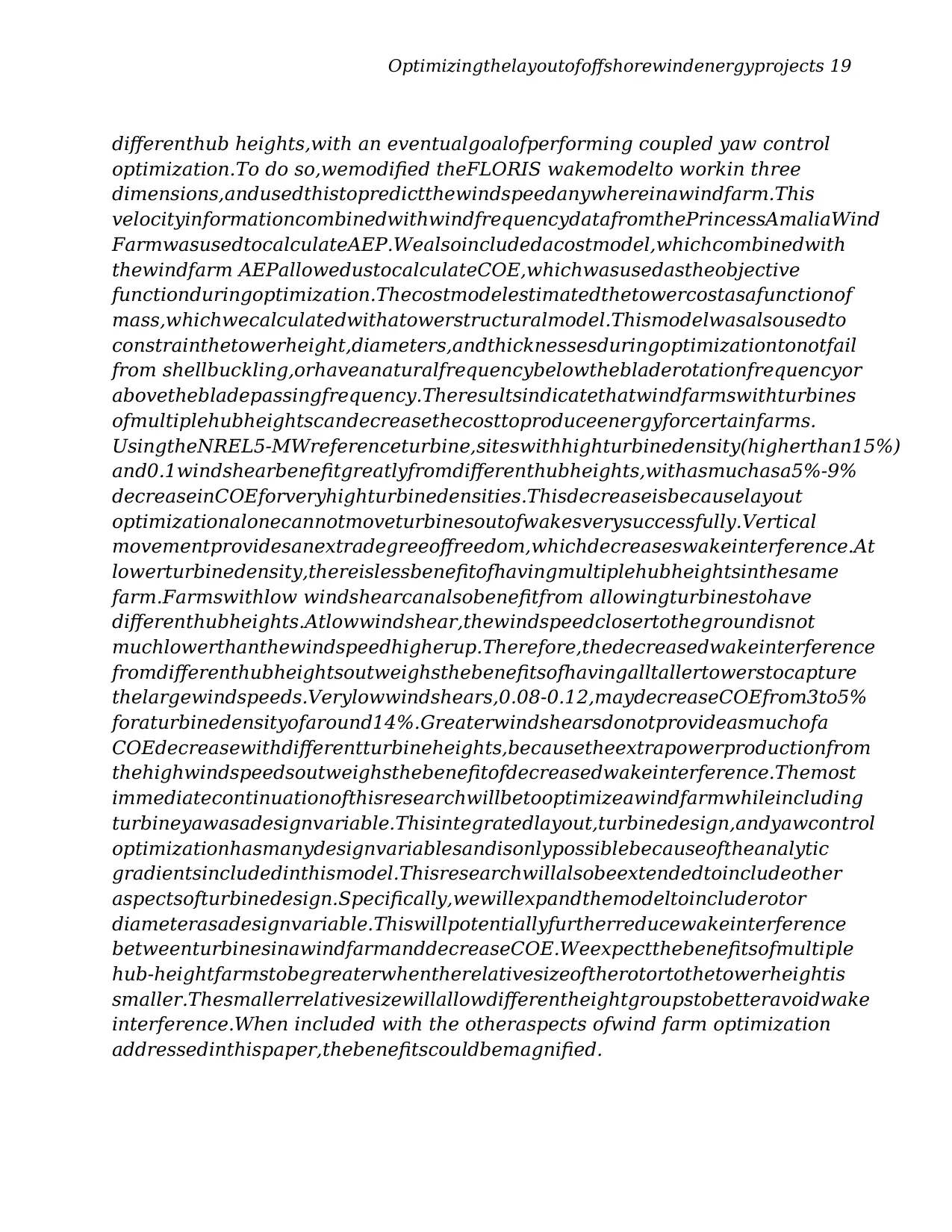
Optimizingthelayoutofoffshorewindenergyprojects 19
differenthub heights,with an eventualgoalofperforming coupled yaw control
optimization.To do so,wemodified theFLORIS wakemodelto workin three
dimensions,andusedthistopredictthewindspeedanywhereinawindfarm.This
velocityinformationcombinedwithwindfrequencydatafromthePrincessAmaliaWind
FarmwasusedtocalculateAEP.Wealsoincludedacostmodel,whichcombinedwith
thewindfarm AEPallowedustocalculateCOE,whichwasusedastheobjective
functionduringoptimization.Thecostmodelestimatedthetowercostasafunctionof
mass,whichwecalculatedwithatowerstructuralmodel.Thismodelwasalsousedto
constrainthetowerheight,diameters,andthicknessesduringoptimizationtonotfail
from shellbuckling,orhaveanaturalfrequencybelowthebladerotationfrequencyor
abovethebladepassingfrequency.Theresultsindicatethatwindfarmswithturbines
ofmultiplehubheightscandecreasethecosttoproduceenergyforcertainfarms.
UsingtheNREL5-MWreferenceturbine,siteswithhighturbinedensity(higherthan15%)
and0.1windshearbenefitgreatlyfromdifferenthubheights,withasmuchasa5%-9%
decreaseinCOEforveryhighturbinedensities.Thisdecreaseisbecauselayout
optimizationalonecannotmoveturbinesoutofwakesverysuccessfully.Vertical
movementprovidesanextradegreeoffreedom,whichdecreaseswakeinterference.At
lowerturbinedensity,thereislessbenefitofhavingmultiplehubheightsinthesame
farm.Farmswithlow windshearcanalsobenefitfrom allowingturbinestohave
differenthubheights.Atlowwindshear,thewindspeedclosertothegroundisnot
muchlowerthanthewindspeedhigherup.Therefore,thedecreasedwakeinterference
fromdifferenthubheightsoutweighsthebenefitsofhavingalltallertowerstocapture
thelargewindspeeds.Verylowwindshears,0.08-0.12,maydecreaseCOEfrom3to5%
foraturbinedensityofaround14%.Greaterwindshearsdonotprovideasmuchofa
COEdecreasewithdifferentturbineheights,becausetheextrapowerproductionfrom
thehighwindspeedsoutweighsthebenefitofdecreasedwakeinterference.Themost
immediatecontinuationofthisresearchwillbetooptimizeawindfarmwhileincluding
turbineyawasadesignvariable.Thisintegratedlayout,turbinedesign,andyawcontrol
optimizationhasmanydesignvariablesandisonlypossiblebecauseoftheanalytic
gradientsincludedinthismodel.Thisresearchwillalsobeextendedtoincludeother
aspectsofturbinedesign.Specifically,wewillexpandthemodeltoincluderotor
diameterasadesignvariable.Thiswillpotentiallyfurtherreducewakeinterference
betweenturbinesinawindfarmanddecreaseCOE.Weexpectthebenefitsofmultiple
hub-heightfarmstobegreaterwhentherelativesizeoftherotortothetowerheightis
smaller.Thesmallerrelativesizewillallowdifferentheightgroupstobetteravoidwake
interference.When included with the otheraspects ofwind farm optimization
addressedinthispaper,thebenefitscouldbemagnified.
differenthub heights,with an eventualgoalofperforming coupled yaw control
optimization.To do so,wemodified theFLORIS wakemodelto workin three
dimensions,andusedthistopredictthewindspeedanywhereinawindfarm.This
velocityinformationcombinedwithwindfrequencydatafromthePrincessAmaliaWind
FarmwasusedtocalculateAEP.Wealsoincludedacostmodel,whichcombinedwith
thewindfarm AEPallowedustocalculateCOE,whichwasusedastheobjective
functionduringoptimization.Thecostmodelestimatedthetowercostasafunctionof
mass,whichwecalculatedwithatowerstructuralmodel.Thismodelwasalsousedto
constrainthetowerheight,diameters,andthicknessesduringoptimizationtonotfail
from shellbuckling,orhaveanaturalfrequencybelowthebladerotationfrequencyor
abovethebladepassingfrequency.Theresultsindicatethatwindfarmswithturbines
ofmultiplehubheightscandecreasethecosttoproduceenergyforcertainfarms.
UsingtheNREL5-MWreferenceturbine,siteswithhighturbinedensity(higherthan15%)
and0.1windshearbenefitgreatlyfromdifferenthubheights,withasmuchasa5%-9%
decreaseinCOEforveryhighturbinedensities.Thisdecreaseisbecauselayout
optimizationalonecannotmoveturbinesoutofwakesverysuccessfully.Vertical
movementprovidesanextradegreeoffreedom,whichdecreaseswakeinterference.At
lowerturbinedensity,thereislessbenefitofhavingmultiplehubheightsinthesame
farm.Farmswithlow windshearcanalsobenefitfrom allowingturbinestohave
differenthubheights.Atlowwindshear,thewindspeedclosertothegroundisnot
muchlowerthanthewindspeedhigherup.Therefore,thedecreasedwakeinterference
fromdifferenthubheightsoutweighsthebenefitsofhavingalltallertowerstocapture
thelargewindspeeds.Verylowwindshears,0.08-0.12,maydecreaseCOEfrom3to5%
foraturbinedensityofaround14%.Greaterwindshearsdonotprovideasmuchofa
COEdecreasewithdifferentturbineheights,becausetheextrapowerproductionfrom
thehighwindspeedsoutweighsthebenefitofdecreasedwakeinterference.Themost
immediatecontinuationofthisresearchwillbetooptimizeawindfarmwhileincluding
turbineyawasadesignvariable.Thisintegratedlayout,turbinedesign,andyawcontrol
optimizationhasmanydesignvariablesandisonlypossiblebecauseoftheanalytic
gradientsincludedinthismodel.Thisresearchwillalsobeextendedtoincludeother
aspectsofturbinedesign.Specifically,wewillexpandthemodeltoincluderotor
diameterasadesignvariable.Thiswillpotentiallyfurtherreducewakeinterference
betweenturbinesinawindfarmanddecreaseCOE.Weexpectthebenefitsofmultiple
hub-heightfarmstobegreaterwhentherelativesizeoftherotortothetowerheightis
smaller.Thesmallerrelativesizewillallowdifferentheightgroupstobetteravoidwake
interference.When included with the otheraspects ofwind farm optimization
addressedinthispaper,thebenefitscouldbemagnified.
Secure Best Marks with AI Grader
Need help grading? Try our AI Grader for instant feedback on your assignments.
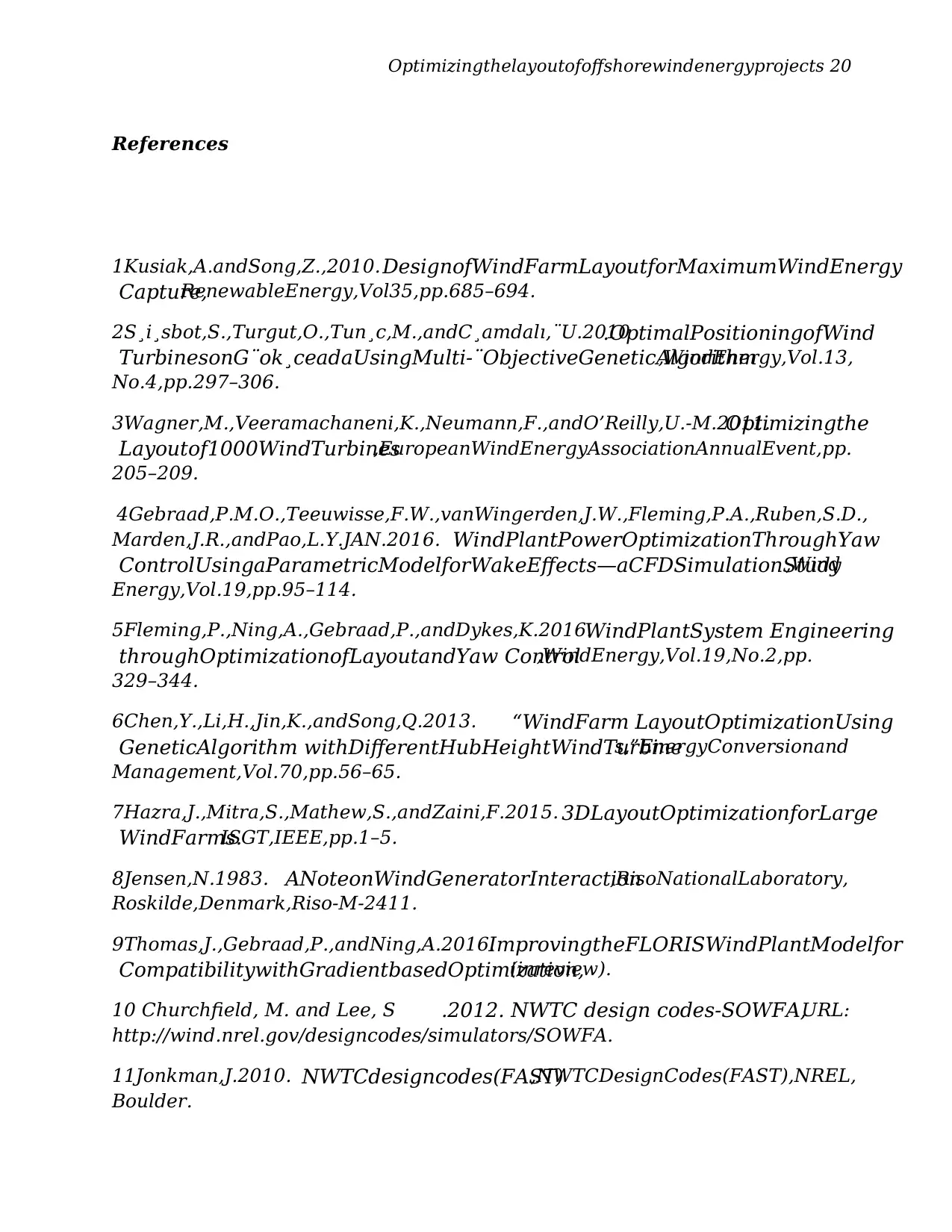
Optimizingthelayoutofoffshorewindenergyprojects 20
References
1Kusiak,A.andSong,Z.,2010. DesignofWindFarmLayoutforMaximumWindEnergy
Capture,RenewableEnergy,Vol35,pp.685–694.
2S¸i¸sbot,S.,Turgut,O.,Tun¸c,M.,andC¸amdalı,¨U.2010.OptimalPositioningofWind
TurbinesonG¨ok¸ceadaUsingMulti-¨ObjectiveGeneticAlgorithm,WindEnergy,Vol.13,
No.4,pp.297–306.
3Wagner,M.,Veeramachaneni,K.,Neumann,F.,andO’Reilly,U.-M.2011.Optimizingthe
Layoutof1000WindTurbines,EuropeanWindEnergyAssociationAnnualEvent,pp.
205–209.
4Gebraad,P.M.O.,Teeuwisse,F.W.,vanWingerden,J.W.,Fleming,P.A.,Ruben,S.D.,
Marden,J.R.,andPao,L.Y.JAN.2016. WindPlantPowerOptimizationThroughYaw
ControlUsingaParametricModelforWakeEffects—aCFDSimulationStudy,Wind
Energy,Vol.19,pp.95–114.
5Fleming,P.,Ning,A.,Gebraad,P.,andDykes,K.2016.WindPlantSystem Engineering
throughOptimizationofLayoutandYaw Control,WindEnergy,Vol.19,No.2,pp.
329–344.
6Chen,Y.,Li,H.,Jin,K.,andSong,Q.2013. “WindFarm LayoutOptimizationUsing
GeneticAlgorithm withDifferentHubHeightWindTurbines,”EnergyConversionand
Management,Vol.70,pp.56–65.
7Hazra,J.,Mitra,S.,Mathew,S.,andZaini,F.2015. 3DLayoutOptimizationforLarge
WindFarms.ISGT,IEEE,pp.1–5.
8Jensen,N.1983. ANoteonWindGeneratorInteraction,RisoNationalLaboratory,
Roskilde,Denmark,Riso-M-2411.
9Thomas,J.,Gebraad,P.,andNing,A.2016.ImprovingtheFLORISWindPlantModelfor
CompatibilitywithGradientbasedOptimization,(inreview).
10 Churchfield, M. and Lee, S .2012. NWTC design codes-SOWFA,URL:
http://wind.nrel.gov/designcodes/simulators/SOWFA.
11Jonkman,J.2010. NWTCdesigncodes(FAST),NWTCDesignCodes(FAST),NREL,
Boulder.
References
1Kusiak,A.andSong,Z.,2010. DesignofWindFarmLayoutforMaximumWindEnergy
Capture,RenewableEnergy,Vol35,pp.685–694.
2S¸i¸sbot,S.,Turgut,O.,Tun¸c,M.,andC¸amdalı,¨U.2010.OptimalPositioningofWind
TurbinesonG¨ok¸ceadaUsingMulti-¨ObjectiveGeneticAlgorithm,WindEnergy,Vol.13,
No.4,pp.297–306.
3Wagner,M.,Veeramachaneni,K.,Neumann,F.,andO’Reilly,U.-M.2011.Optimizingthe
Layoutof1000WindTurbines,EuropeanWindEnergyAssociationAnnualEvent,pp.
205–209.
4Gebraad,P.M.O.,Teeuwisse,F.W.,vanWingerden,J.W.,Fleming,P.A.,Ruben,S.D.,
Marden,J.R.,andPao,L.Y.JAN.2016. WindPlantPowerOptimizationThroughYaw
ControlUsingaParametricModelforWakeEffects—aCFDSimulationStudy,Wind
Energy,Vol.19,pp.95–114.
5Fleming,P.,Ning,A.,Gebraad,P.,andDykes,K.2016.WindPlantSystem Engineering
throughOptimizationofLayoutandYaw Control,WindEnergy,Vol.19,No.2,pp.
329–344.
6Chen,Y.,Li,H.,Jin,K.,andSong,Q.2013. “WindFarm LayoutOptimizationUsing
GeneticAlgorithm withDifferentHubHeightWindTurbines,”EnergyConversionand
Management,Vol.70,pp.56–65.
7Hazra,J.,Mitra,S.,Mathew,S.,andZaini,F.2015. 3DLayoutOptimizationforLarge
WindFarms.ISGT,IEEE,pp.1–5.
8Jensen,N.1983. ANoteonWindGeneratorInteraction,RisoNationalLaboratory,
Roskilde,Denmark,Riso-M-2411.
9Thomas,J.,Gebraad,P.,andNing,A.2016.ImprovingtheFLORISWindPlantModelfor
CompatibilitywithGradientbasedOptimization,(inreview).
10 Churchfield, M. and Lee, S .2012. NWTC design codes-SOWFA,URL:
http://wind.nrel.gov/designcodes/simulators/SOWFA.
11Jonkman,J.2010. NWTCdesigncodes(FAST),NWTCDesignCodes(FAST),NREL,
Boulder.
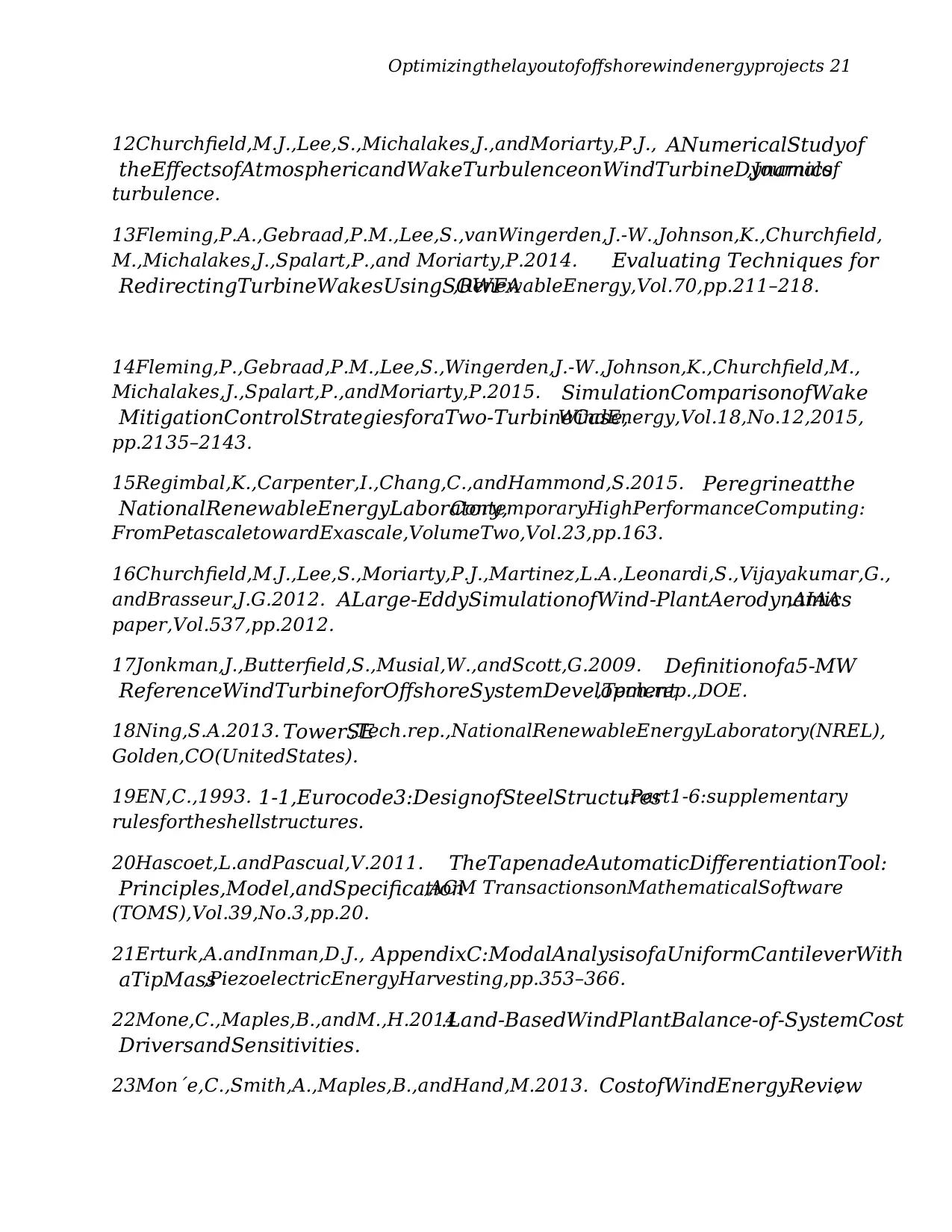
Optimizingthelayoutofoffshorewindenergyprojects 21
12Churchfield,M.J.,Lee,S.,Michalakes,J.,andMoriarty,P.J., ANumericalStudyof
theEffectsofAtmosphericandWakeTurbulenceonWindTurbineDynamics,Journalof
turbulence.
13Fleming,P.A.,Gebraad,P.M.,Lee,S.,vanWingerden,J.-W.,Johnson,K.,Churchfield,
M.,Michalakes,J.,Spalart,P.,and Moriarty,P.2014. Evaluating Techniques for
RedirectingTurbineWakesUsingSOWFA,RenewableEnergy,Vol.70,pp.211–218.
14Fleming,P.,Gebraad,P.M.,Lee,S.,Wingerden,J.-W.,Johnson,K.,Churchfield,M.,
Michalakes,J.,Spalart,P.,andMoriarty,P.2015. SimulationComparisonofWake
MitigationControlStrategiesforaTwo-TurbineCase,WindEnergy,Vol.18,No.12,2015,
pp.2135–2143.
15Regimbal,K.,Carpenter,I.,Chang,C.,andHammond,S.2015. Peregrineatthe
NationalRenewableEnergyLaboratory,ContemporaryHighPerformanceComputing:
FromPetascaletowardExascale,VolumeTwo,Vol.23,pp.163.
16Churchfield,M.J.,Lee,S.,Moriarty,P.J.,Martinez,L.A.,Leonardi,S.,Vijayakumar,G.,
andBrasseur,J.G.2012. ALarge-EddySimulationofWind-PlantAerodynamics,AIAA
paper,Vol.537,pp.2012.
17Jonkman,J.,Butterfield,S.,Musial,W.,andScott,G.2009. Definitionofa5-MW
ReferenceWindTurbineforOffshoreSystemDevelopment,Tech.rep.,DOE.
18Ning,S.A.2013. TowerSE,Tech.rep.,NationalRenewableEnergyLaboratory(NREL),
Golden,CO(UnitedStates).
19EN,C.,1993. 1-1,Eurocode3:DesignofSteelStructures,Part1-6:supplementary
rulesfortheshellstructures.
20Hascoet,L.andPascual,V.2011. TheTapenadeAutomaticDifferentiationTool:
Principles,Model,andSpecification,ACM TransactionsonMathematicalSoftware
(TOMS),Vol.39,No.3,pp.20.
21Erturk,A.andInman,D.J., AppendixC:ModalAnalysisofaUniformCantileverWith
aTipMass,PiezoelectricEnergyHarvesting,pp.353–366.
22Mone,C.,Maples,B.,andM.,H.2014.Land-BasedWindPlantBalance-of-SystemCost
DriversandSensitivities.
23Mon´e,C.,Smith,A.,Maples,B.,andHand,M.2013. CostofWindEnergyReview,
12Churchfield,M.J.,Lee,S.,Michalakes,J.,andMoriarty,P.J., ANumericalStudyof
theEffectsofAtmosphericandWakeTurbulenceonWindTurbineDynamics,Journalof
turbulence.
13Fleming,P.A.,Gebraad,P.M.,Lee,S.,vanWingerden,J.-W.,Johnson,K.,Churchfield,
M.,Michalakes,J.,Spalart,P.,and Moriarty,P.2014. Evaluating Techniques for
RedirectingTurbineWakesUsingSOWFA,RenewableEnergy,Vol.70,pp.211–218.
14Fleming,P.,Gebraad,P.M.,Lee,S.,Wingerden,J.-W.,Johnson,K.,Churchfield,M.,
Michalakes,J.,Spalart,P.,andMoriarty,P.2015. SimulationComparisonofWake
MitigationControlStrategiesforaTwo-TurbineCase,WindEnergy,Vol.18,No.12,2015,
pp.2135–2143.
15Regimbal,K.,Carpenter,I.,Chang,C.,andHammond,S.2015. Peregrineatthe
NationalRenewableEnergyLaboratory,ContemporaryHighPerformanceComputing:
FromPetascaletowardExascale,VolumeTwo,Vol.23,pp.163.
16Churchfield,M.J.,Lee,S.,Moriarty,P.J.,Martinez,L.A.,Leonardi,S.,Vijayakumar,G.,
andBrasseur,J.G.2012. ALarge-EddySimulationofWind-PlantAerodynamics,AIAA
paper,Vol.537,pp.2012.
17Jonkman,J.,Butterfield,S.,Musial,W.,andScott,G.2009. Definitionofa5-MW
ReferenceWindTurbineforOffshoreSystemDevelopment,Tech.rep.,DOE.
18Ning,S.A.2013. TowerSE,Tech.rep.,NationalRenewableEnergyLaboratory(NREL),
Golden,CO(UnitedStates).
19EN,C.,1993. 1-1,Eurocode3:DesignofSteelStructures,Part1-6:supplementary
rulesfortheshellstructures.
20Hascoet,L.andPascual,V.2011. TheTapenadeAutomaticDifferentiationTool:
Principles,Model,andSpecification,ACM TransactionsonMathematicalSoftware
(TOMS),Vol.39,No.3,pp.20.
21Erturk,A.andInman,D.J., AppendixC:ModalAnalysisofaUniformCantileverWith
aTipMass,PiezoelectricEnergyHarvesting,pp.353–366.
22Mone,C.,Maples,B.,andM.,H.2014.Land-BasedWindPlantBalance-of-SystemCost
DriversandSensitivities.
23Mon´e,C.,Smith,A.,Maples,B.,andHand,M.2013. CostofWindEnergyReview,

Optimizingthelayoutofoffshorewindenergyprojects 22
Tech.rep.,NREL/TP-5000-63267.Golden,Colorado:NationalRenewable Energy
Laboratory.
24Gray,J.,Moore,T.,andNAYLOR,B.A.,2010.OpenMDAO:AnOpenSourceFrameworkFor
Multidisciplinary Analysis And Optimization,AIAA/ISSMO Multidisciplinary Analysi
OptimizationConferenceProceedings,vol5.
25ManwellJ.F,McGowanJ.G,and RogersA.L.,2009. Chapter3-Aerodynamicsof
WindTurbines,inWindEnergyExplained.
26 Réthoré P.E. ,2009.Wind Turbine Wake in Atmospheric Turbulence,Aalborg
University.
27-Attenuationofsoundduringpropagationoutdoors-Part2:Gen ,Acousticseral
methodofcalculation(ISO9613-2:1996).
28ZitzlerE.,andThieleL.,1999. Multiobjectiveevolutionaryalgorithms:acomparative
casestudyandthestrengthParetoapproach,IEEETransactionsonEvolutionary
Computation,vol.3,no.4,pp.257-271.
29ZitzlerE.,LaumannsM.,andThieleL. ,2001.SPEA2:ImprovingtheStrengthPareto
EvolutionaryAlgorithm forMultiobjectiveOptimization,inEvolutionaryMethodsfor
Design,OptimisationandControlwithApplicationtoIndustrialProblems(EUROGEN
2001),pp.95-100.
30SrinivasN.andDebK.,Sep1994 .MuiltiobjectiveOptimizationUsingNondominated
SortinginGeneticAlgorithms,EvolutionaryComputation,vol.2,no.3,pp.221-248.
31DebK., PratapA., Agarwal S.,and Meyarivan T.2002. A fastandelitist
multiobjective genetic algorithm: NSGAII,IEEE Transactions on Evolutionary
Computation,vol.6,no.2,pp.182-197.
32 ZitzlerE.,DebK.,andThieleL. 2002.Comparisonofmultiobjectiveevolutionary
algorithms:empiricalresults.,Evolutionarycomputation,vol.8,no.2,pp.173-95,Jan.
2000.
33RogersA.L.andManwellJ.F.,2004. WindTurbineNoiseIssues,Amherst.
342011.openWind.AWSTruepower,Albany,NY.
352010. OpenWindTheoreticalbasisandValidation.AWSTruepower,Albany,NY.
Tech.rep.,NREL/TP-5000-63267.Golden,Colorado:NationalRenewable Energy
Laboratory.
24Gray,J.,Moore,T.,andNAYLOR,B.A.,2010.OpenMDAO:AnOpenSourceFrameworkFor
Multidisciplinary Analysis And Optimization,AIAA/ISSMO Multidisciplinary Analysi
OptimizationConferenceProceedings,vol5.
25ManwellJ.F,McGowanJ.G,and RogersA.L.,2009. Chapter3-Aerodynamicsof
WindTurbines,inWindEnergyExplained.
26 Réthoré P.E. ,2009.Wind Turbine Wake in Atmospheric Turbulence,Aalborg
University.
27-Attenuationofsoundduringpropagationoutdoors-Part2:Gen ,Acousticseral
methodofcalculation(ISO9613-2:1996).
28ZitzlerE.,andThieleL.,1999. Multiobjectiveevolutionaryalgorithms:acomparative
casestudyandthestrengthParetoapproach,IEEETransactionsonEvolutionary
Computation,vol.3,no.4,pp.257-271.
29ZitzlerE.,LaumannsM.,andThieleL. ,2001.SPEA2:ImprovingtheStrengthPareto
EvolutionaryAlgorithm forMultiobjectiveOptimization,inEvolutionaryMethodsfor
Design,OptimisationandControlwithApplicationtoIndustrialProblems(EUROGEN
2001),pp.95-100.
30SrinivasN.andDebK.,Sep1994 .MuiltiobjectiveOptimizationUsingNondominated
SortinginGeneticAlgorithms,EvolutionaryComputation,vol.2,no.3,pp.221-248.
31DebK., PratapA., Agarwal S.,and Meyarivan T.2002. A fastandelitist
multiobjective genetic algorithm: NSGAII,IEEE Transactions on Evolutionary
Computation,vol.6,no.2,pp.182-197.
32 ZitzlerE.,DebK.,andThieleL. 2002.Comparisonofmultiobjectiveevolutionary
algorithms:empiricalresults.,Evolutionarycomputation,vol.8,no.2,pp.173-95,Jan.
2000.
33RogersA.L.andManwellJ.F.,2004. WindTurbineNoiseIssues,Amherst.
342011.openWind.AWSTruepower,Albany,NY.
352010. OpenWindTheoreticalbasisandValidation.AWSTruepower,Albany,NY.
Paraphrase This Document
Need a fresh take? Get an instant paraphrase of this document with our AI Paraphraser
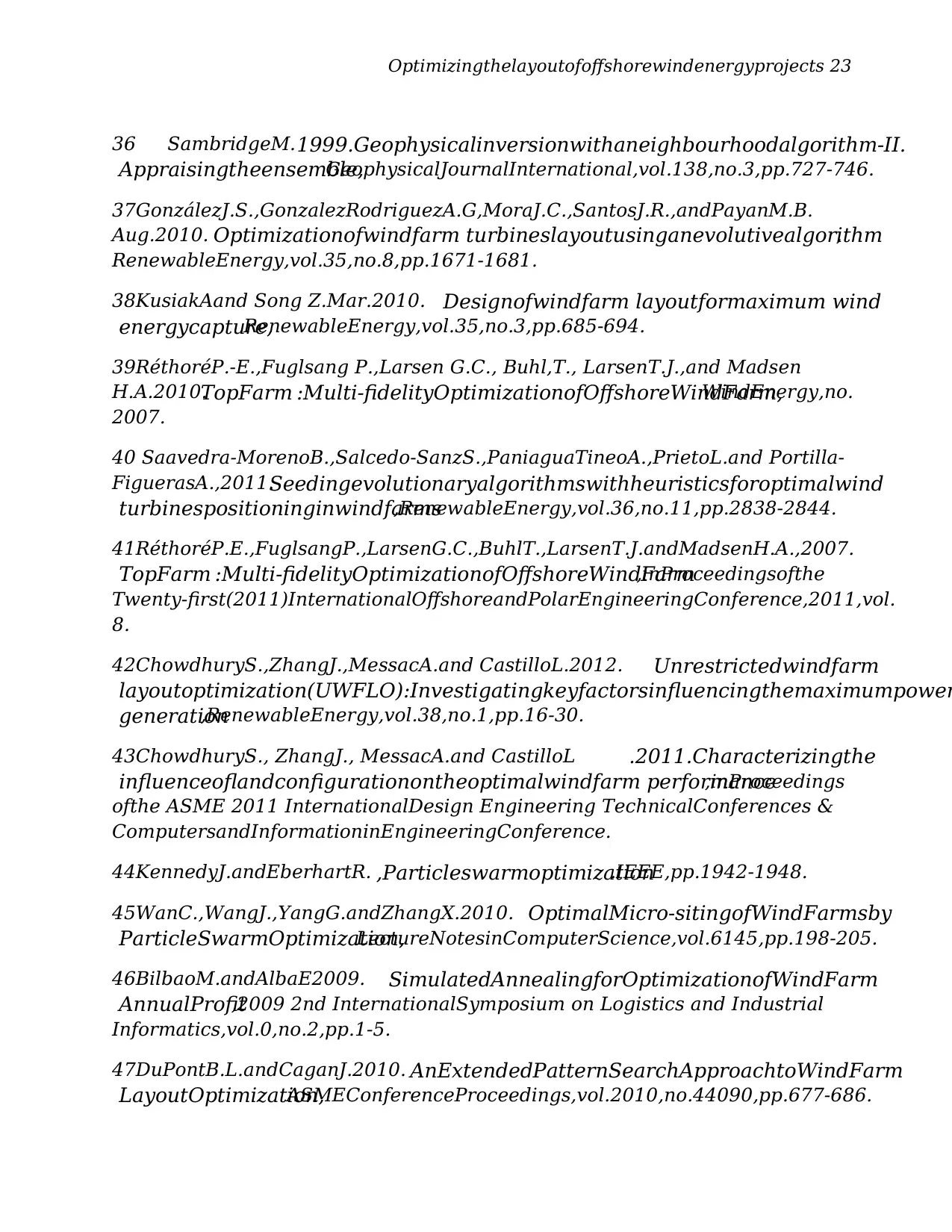
Optimizingthelayoutofoffshorewindenergyprojects 23
36 SambridgeM.1999.Geophysicalinversionwithaneighbourhoodalgorithm-II.
Appraisingtheensemble,GeophysicalJournalInternational,vol.138,no.3,pp.727-746.
37GonzálezJ.S.,GonzalezRodriguezA.G,MoraJ.C.,SantosJ.R.,andPayanM.B.
Aug.2010. Optimizationofwindfarm turbineslayoutusinganevolutivealgorithm,
RenewableEnergy,vol.35,no.8,pp.1671-1681.
38KusiakAand Song Z.Mar.2010. Designofwindfarm layoutformaximum wind
energycapture,RenewableEnergy,vol.35,no.3,pp.685-694.
39RéthoréP.-E.,Fuglsang P.,Larsen G.C., Buhl,T., LarsenT.J.,and Madsen
H.A.2010.TopFarm :Multi-fidelityOptimizationofOffshoreWindFarm,WindEnergy,no.
2007.
40 Saavedra-MorenoB.,Salcedo-SanzS.,PaniaguaTineoA.,PrietoL.and Portilla-
FiguerasA.,2011.Seedingevolutionaryalgorithmswithheuristicsforoptimalwind
turbinespositioninginwindfarms,RenewableEnergy,vol.36,no.11,pp.2838-2844.
41RéthoréP.E.,FuglsangP.,LarsenG.C.,BuhlT.,LarsenT.J.andMadsenH.A.,2007.
TopFarm :Multi-fidelityOptimizationofOffshoreWindFarm,inProceedingsofthe
Twenty-first(2011)InternationalOffshoreandPolarEngineeringConference,2011,vol.
8.
42ChowdhuryS.,ZhangJ.,MessacA.and CastilloL.2012. Unrestrictedwindfarm
layoutoptimization(UWFLO):Investigatingkeyfactorsinfluencingthemaximumpower
generation,RenewableEnergy,vol.38,no.1,pp.16-30.
43ChowdhuryS., ZhangJ., MessacA.and CastilloL .2011.Characterizingthe
influenceoflandconfigurationontheoptimalwindfarm performance,inProceedings
ofthe ASME 2011 InternationalDesign Engineering TechnicalConferences &
ComputersandInformationinEngineeringConference.
44KennedyJ.andEberhartR. ,Particleswarmoptimization.IEEE,pp.1942-1948.
45WanC.,WangJ.,YangG.andZhangX.2010. OptimalMicro-sitingofWindFarmsby
ParticleSwarmOptimization,LectureNotesinComputerScience,vol.6145,pp.198-205.
46BilbaoM.andAlbaE2009. SimulatedAnnealingforOptimizationofWindFarm
AnnualProfit,2009 2nd InternationalSymposium on Logistics and Industrial
Informatics,vol.0,no.2,pp.1-5.
47DuPontB.L.andCaganJ.2010. AnExtendedPatternSearchApproachtoWindFarm
LayoutOptimization,ASMEConferenceProceedings,vol.2010,no.44090,pp.677-686.
36 SambridgeM.1999.Geophysicalinversionwithaneighbourhoodalgorithm-II.
Appraisingtheensemble,GeophysicalJournalInternational,vol.138,no.3,pp.727-746.
37GonzálezJ.S.,GonzalezRodriguezA.G,MoraJ.C.,SantosJ.R.,andPayanM.B.
Aug.2010. Optimizationofwindfarm turbineslayoutusinganevolutivealgorithm,
RenewableEnergy,vol.35,no.8,pp.1671-1681.
38KusiakAand Song Z.Mar.2010. Designofwindfarm layoutformaximum wind
energycapture,RenewableEnergy,vol.35,no.3,pp.685-694.
39RéthoréP.-E.,Fuglsang P.,Larsen G.C., Buhl,T., LarsenT.J.,and Madsen
H.A.2010.TopFarm :Multi-fidelityOptimizationofOffshoreWindFarm,WindEnergy,no.
2007.
40 Saavedra-MorenoB.,Salcedo-SanzS.,PaniaguaTineoA.,PrietoL.and Portilla-
FiguerasA.,2011.Seedingevolutionaryalgorithmswithheuristicsforoptimalwind
turbinespositioninginwindfarms,RenewableEnergy,vol.36,no.11,pp.2838-2844.
41RéthoréP.E.,FuglsangP.,LarsenG.C.,BuhlT.,LarsenT.J.andMadsenH.A.,2007.
TopFarm :Multi-fidelityOptimizationofOffshoreWindFarm,inProceedingsofthe
Twenty-first(2011)InternationalOffshoreandPolarEngineeringConference,2011,vol.
8.
42ChowdhuryS.,ZhangJ.,MessacA.and CastilloL.2012. Unrestrictedwindfarm
layoutoptimization(UWFLO):Investigatingkeyfactorsinfluencingthemaximumpower
generation,RenewableEnergy,vol.38,no.1,pp.16-30.
43ChowdhuryS., ZhangJ., MessacA.and CastilloL .2011.Characterizingthe
influenceoflandconfigurationontheoptimalwindfarm performance,inProceedings
ofthe ASME 2011 InternationalDesign Engineering TechnicalConferences &
ComputersandInformationinEngineeringConference.
44KennedyJ.andEberhartR. ,Particleswarmoptimization.IEEE,pp.1942-1948.
45WanC.,WangJ.,YangG.andZhangX.2010. OptimalMicro-sitingofWindFarmsby
ParticleSwarmOptimization,LectureNotesinComputerScience,vol.6145,pp.198-205.
46BilbaoM.andAlbaE2009. SimulatedAnnealingforOptimizationofWindFarm
AnnualProfit,2009 2nd InternationalSymposium on Logistics and Industrial
Informatics,vol.0,no.2,pp.1-5.
47DuPontB.L.andCaganJ.2010. AnExtendedPatternSearchApproachtoWindFarm
LayoutOptimization,ASMEConferenceProceedings,vol.2010,no.44090,pp.677-686.

Optimizingthelayoutofoffshorewindenergyprojects 24
48DonovanS.,NatesG.,WatererH.andArcherR.2008. MixedIntegerProgramming
ModelsforWindFarmDesignColumbiaUniversity,NewYorkCity,NewYork.NewYork
City.
48DonovanS.,NatesG.,WatererH.andArcherR.2008. MixedIntegerProgramming
ModelsforWindFarmDesignColumbiaUniversity,NewYorkCity,NewYork.NewYork
City.
1 out of 24
Your All-in-One AI-Powered Toolkit for Academic Success.
+13062052269
info@desklib.com
Available 24*7 on WhatsApp / Email
![[object Object]](/_next/static/media/star-bottom.7253800d.svg)
Unlock your academic potential
© 2024 | Zucol Services PVT LTD | All rights reserved.

